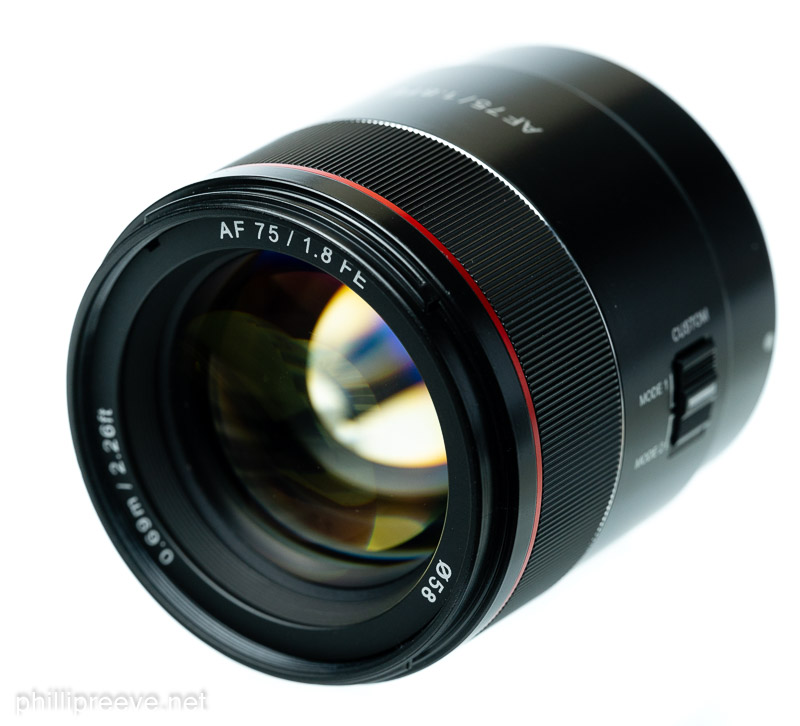 “Tiny but ABSOLUTE” that’s Samyang’s claim for their AF 75/1.8 FE lens. One could add that it is one of the cheapest lenses for the system. So what can you expect from a 230g lens for $399? Read on if you want to know.
“Tiny but ABSOLUTE” that’s Samyang’s claim for their AF 75/1.8 FE lens. One could add that it is one of the cheapest lenses for the system. So what can you expect from a 230g lens for $399? Read on if you want to know.
Samyang AF 75/1.8 FE Review
Most images in this review can be found in full resolution in my Samyang AF 75/1.8 FE flickr set. There you can also browse samples in a very high quality browser.
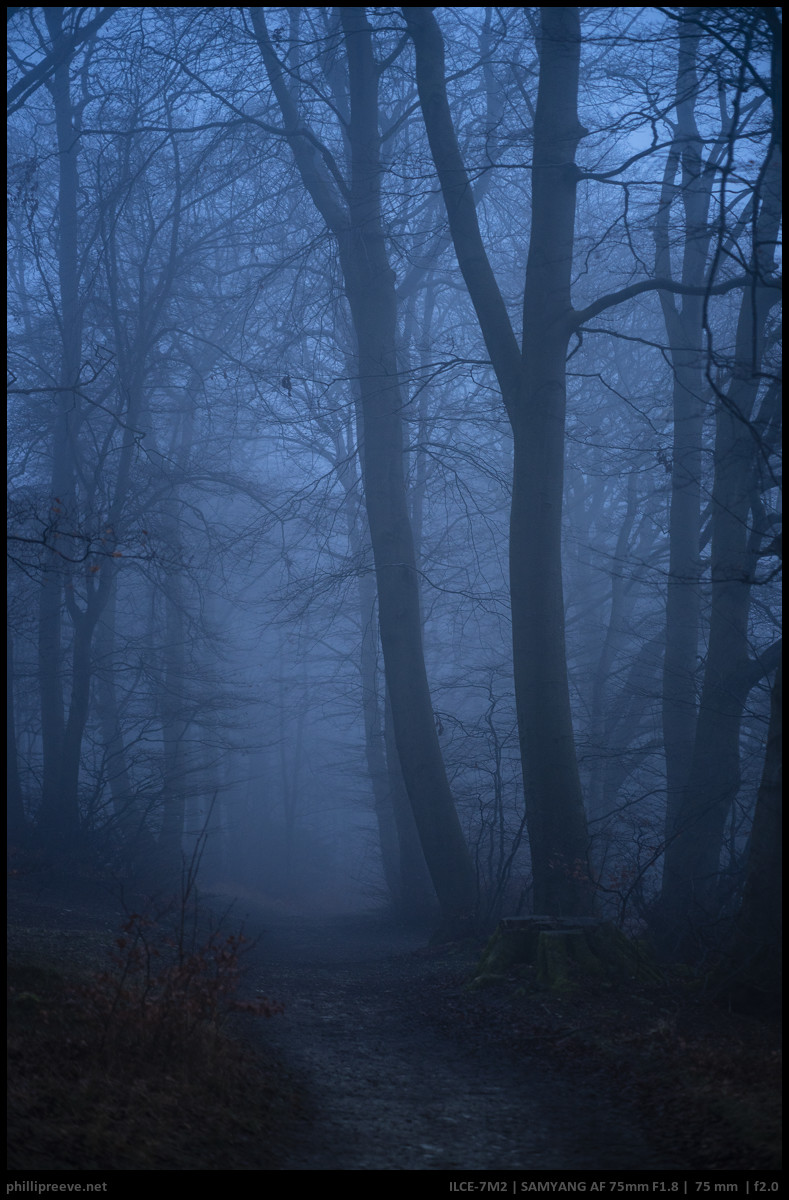
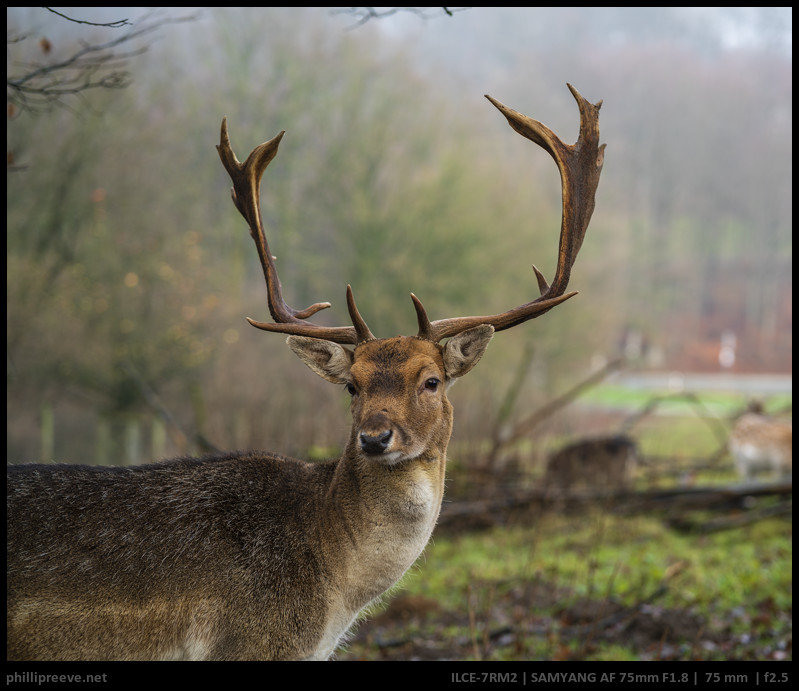
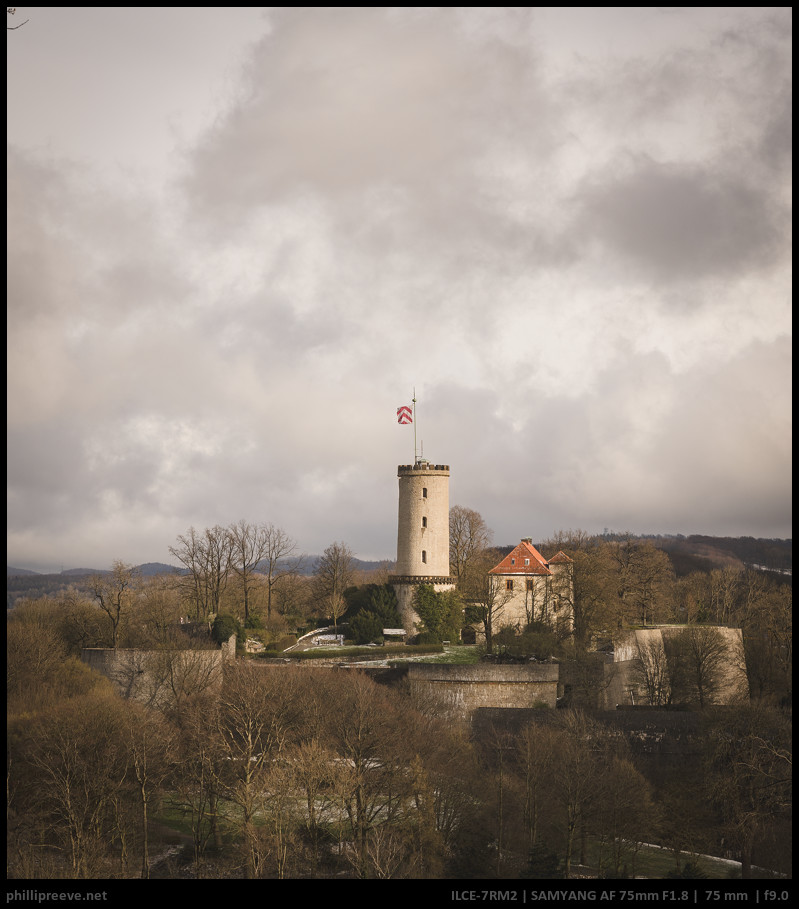
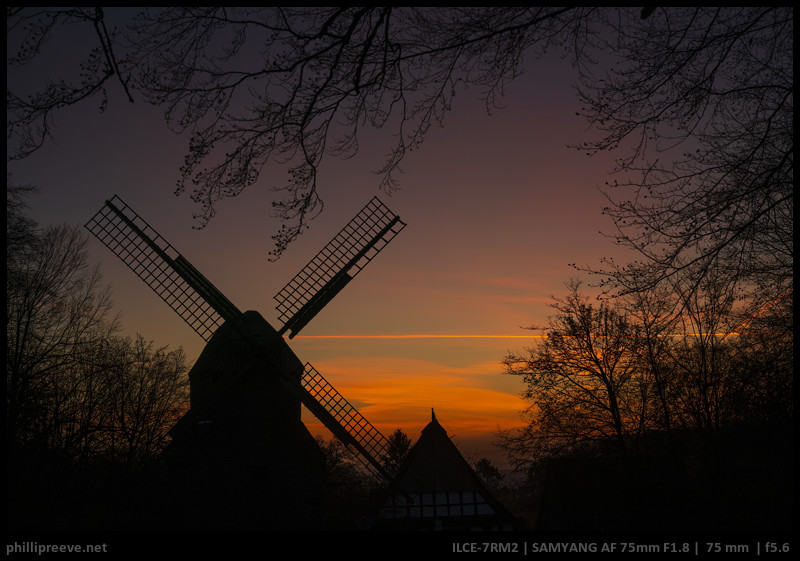
Specifications
| Diameter | 65 mm |
| Length | 74 mm |
| Filter Thread | 58 mm |
| Weight (no hood, no caps) | 230 g |
| Max. Magnification | 0.13 |
| Close Focusing Distance from the sensor | 69 cm |
| Number of aperture blades | 9 |
| Elements/ Groups | 10/9 |
| Mount | E-mount |
The Samyang 75/1.8 has a recommended price of $399. Check current prices at amazon.com, B&H or ebay.com. In Germany the recommended price is 399 €. Check at amazon.de.
If you purchase the lens through one of these affiliate-links I get a small compensation with no additional cost to you.
Disclosure
I bought this copy used with my own money and used it for several months before writing this review. In fact I had to return my first copy because it was decentered.
Versions
In the US the Samyang 75/1.8 is also sold under under the Rokinon and Bower brands. As far as I am aware the only difference is the name tag.
Features
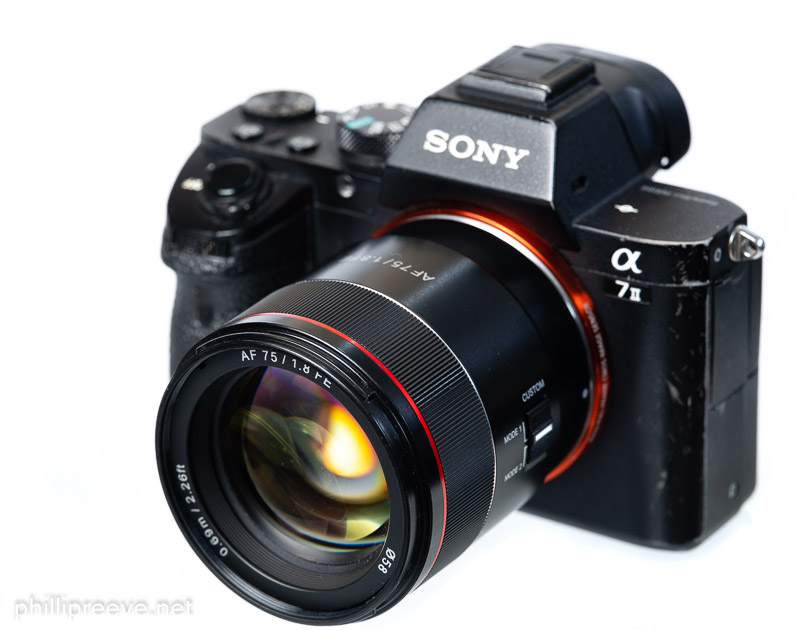
The Samyang AF 75/1.8 FE offers a custom switch you can program with help of the lens station.
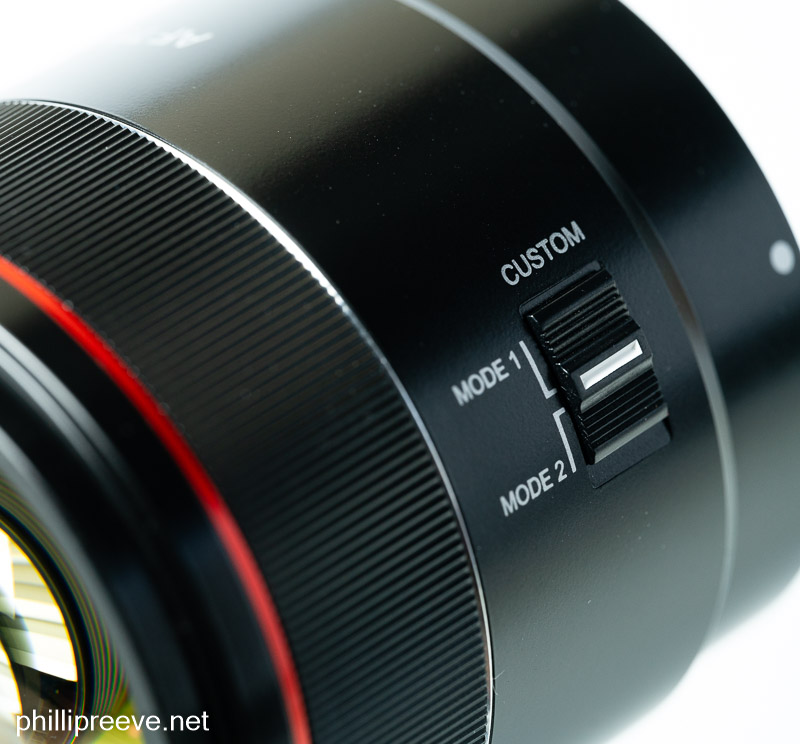
You have three options here
- Aperture Control: The focusing ring controls the aperture
- Normal Control: The lens uses AF
- Manual Focus: Switches the lens to MF
So basically it is a AF/MF-Switch which can also be used to switch to aperture control but only if you use AF.
While I have mentioned the lens station I would like to share a few thoughts about it. It costs $60 (affiliate link) and with it you can do several things:
- update the firmware
- calibrate the AF
- program the custom switch
- change the sensitivity of the focus ring
In my eyes the lens station is a two edged sword. Samyang has in the past released lenses with firmware which wasn’t well tested. Their 1.4/35 for example with firmware version 1 froze my camera several times while shooting a wedding and it had big AF-issues. Only since version 4 of the firmware have these issues been fixed. So to properly use my lens I was forced to buy the lens station to update the firmware. This is certainly an effective cost saving measure and not unheard of in the tech-world. If you let the users do the beta testing you can release earlier and save on testing which is why I would be rather hesitant about buying Samyang lenses right after release. On the other hand I have run the 75/1.8 in Version 1 of the firmware for some time and not noticed any obvious issues.
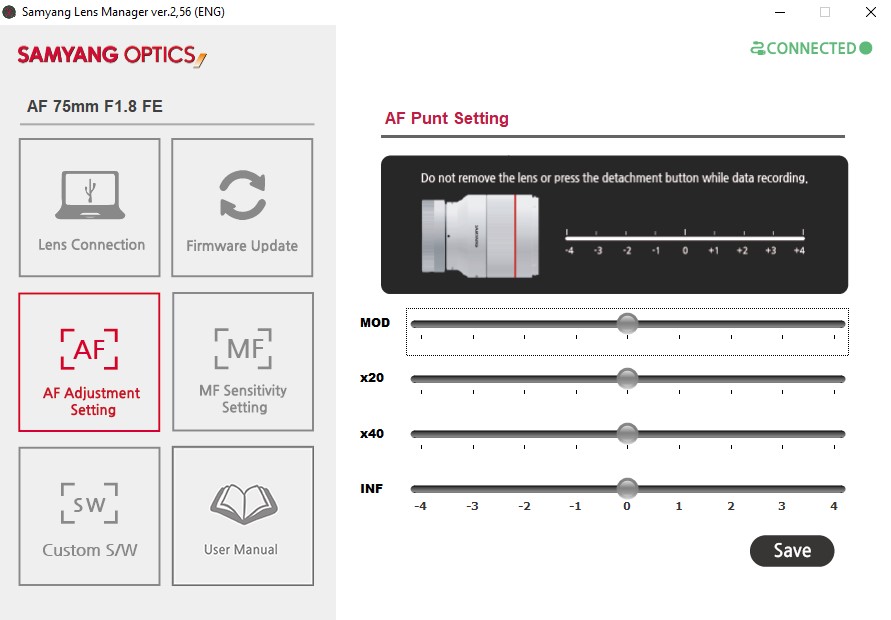
I don’t get why one would have to change the AF calibration. One big advantage of mirrorless is that AF-calibration issues have been overcome by all manufacturers.
Programming the custom switch is a nice little feature which I personally have used. I wouldn’t have bought a $60 lens station for it but since I already owned it I was happy to use this feature.
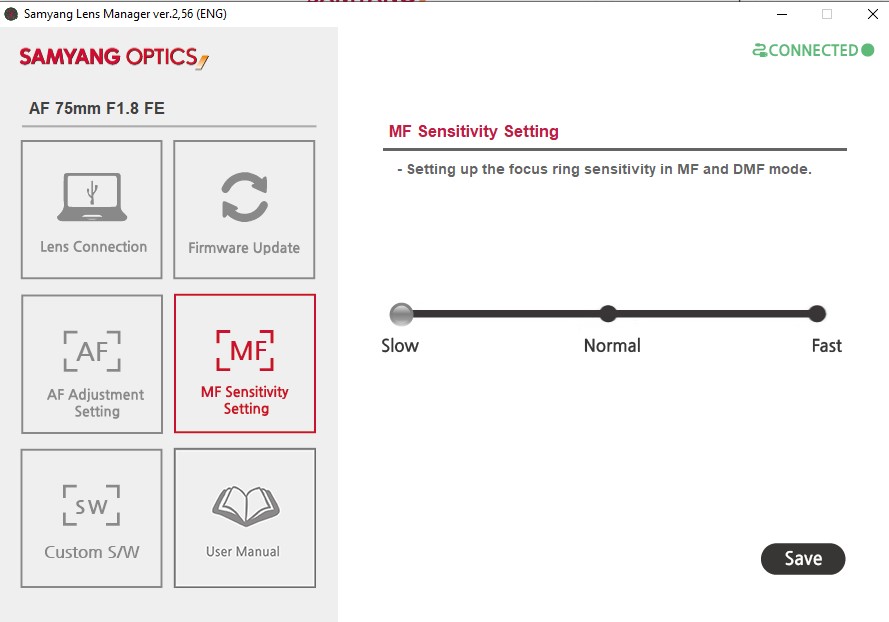
The ability to change MF-sensitivity on the other hand is a useful feature in my eyes because for some applications you want a higher sensitivity than for others.
Overall I would have preferred if the firmware could be updated via the camera like it works with other manufacturers but at least you get some features out of the lens station.
Build quality
The Samyang AF 75/1.8 FE feels solid enough but the materials reflect the lower price. The hull ist made from plastics and the wide enough focus ring is a little scratchy with a lower resistance. Markings are only printed on and not engraved.
Samyang does not claim any weather resistance and the 75/1.8 does not have a rubber gasket.
My first copy of the Samang 75mm F1.8 was severely decentered so I had to return it.
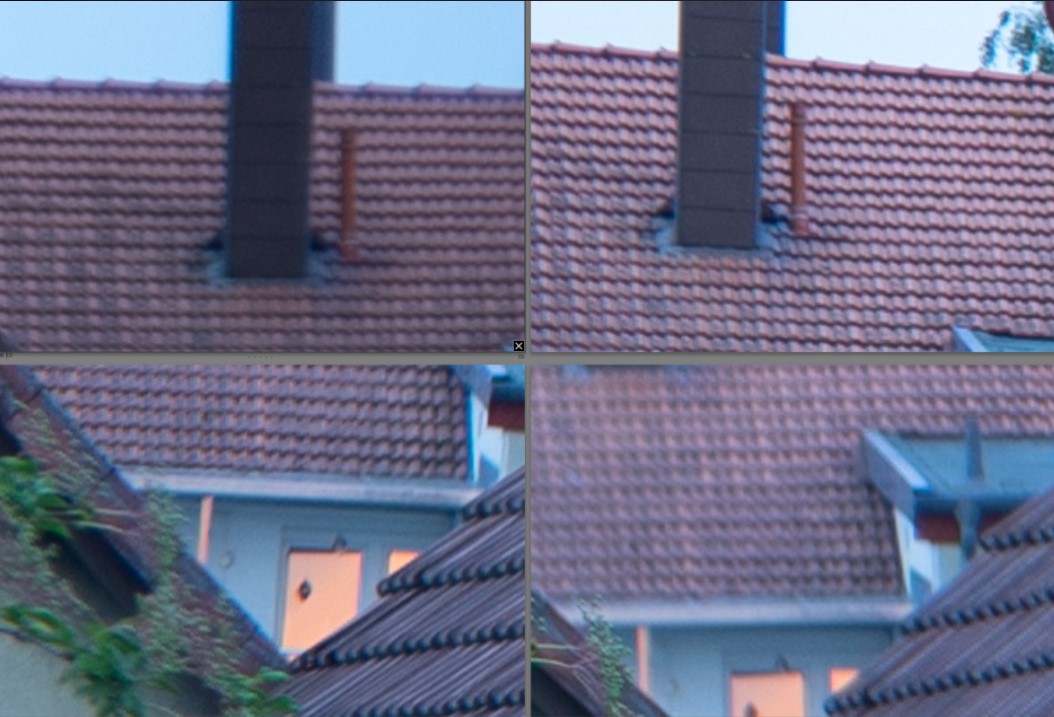
As a team we have had several bad experiences with Samyang lenses which broke for no obvious reason: an experience many other users have had as well, going by forum entries and Amazon reviews. Also we have experienced above average variation with Samyang lenses as documented by lensrentals.com. In our case more than half the Samyang lenses we have tested were decentered. Because of that experience we recommend to only buy a Samyang lens if you feel competent to do a decentering test and have the right to return the lens after testing. Of course lenses from other manufacturers are often decentered or break as well but it seems to be a lot more likely with Samyang lenses. Less strict quality control seems to be another reason why Samyang lenses can be so cheap. The risk should be kept in mind when buying one of their lenses. On the plus side of things the issue is offset in part by generous warranties offered by Samyang in some markets.
Handling
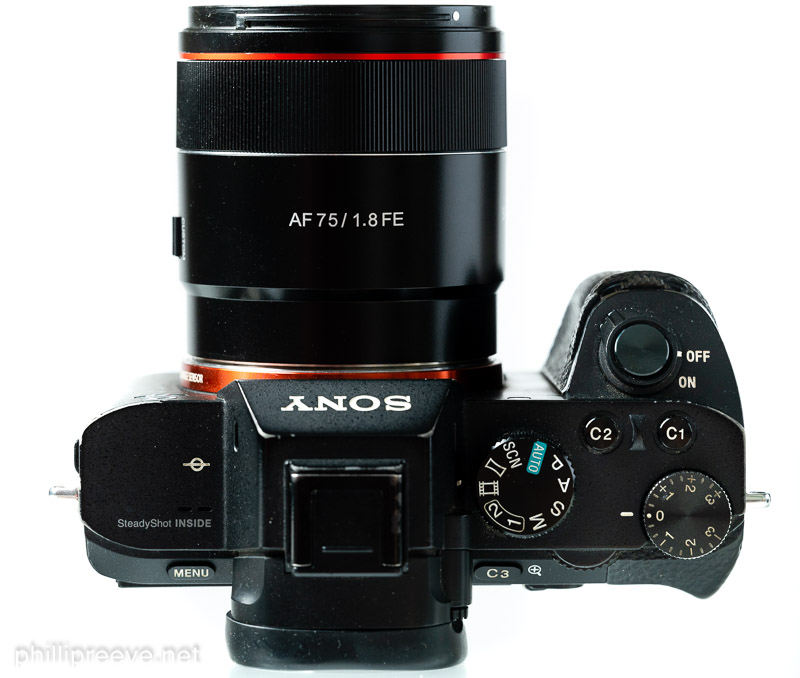
AF
On the a7rII the Samyang AF 75/1.8 FE focuses as quick as the Sony FE 1.8/85. The AF makes a very small noise which might be an issues for video but it is a non-issue for photography. Accuracy and repeatability seemed to be a bit lower than that of the FE 1.8/85 but not by much.
Manual Focus
The focus ring offers a reasonable amount of resistance in my eyes. It isn’t linear but close to that. In the slow setting it travels around 360° from 0.69m to infinity, in the normal setting it takes about 270° and in the fast setting it takes about 180°. Personally I prefer the slow setting and MF worked well enough for me. Manual focus with the Samyang 75/1.8 is no joy but it is usable.
Hood
The Samyang 75/1.8’s hood is made from plastics, locks safely into place and protects the front of the lens well. Since it can be mounted in reverse and then takes up very little space I can’t find any fault with its large volume relative to the small lens.
Size and Weight
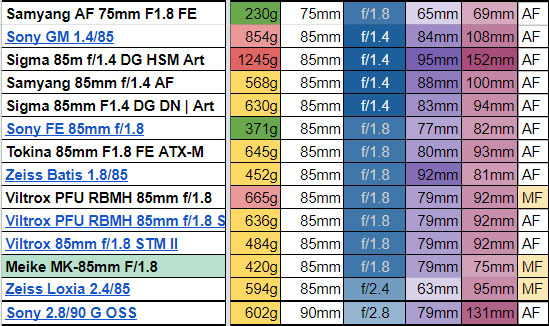
At just 230g the Samyang 75/1.8 is by some margin the lightest and smallest E-mount lens above 55mm.
Optical performance
These results are based on the use with a Sony Alpha 7rII.
Flare Resistance
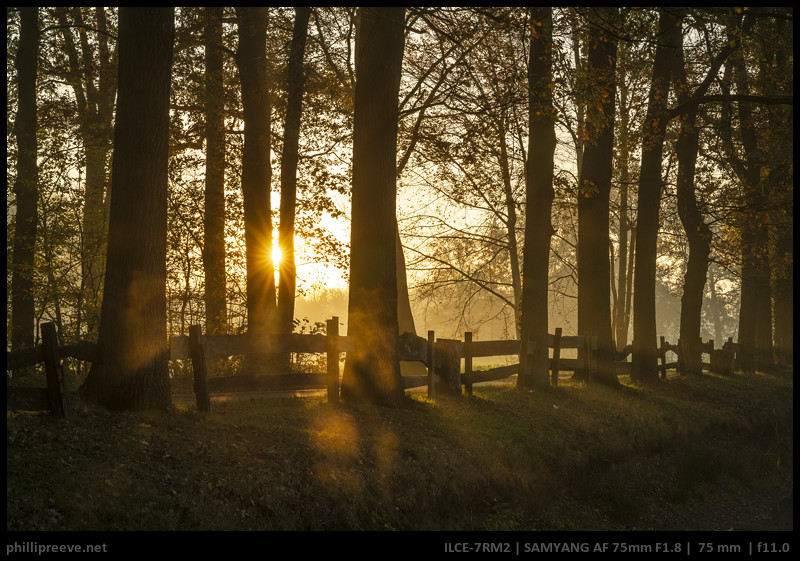
As always evaluating flare is a complex matter since you can get any lens to look bad if you push it hard enough and a slight change of scenario will affect results a lot.
I see some veiling flare and relatively strong veiling flare. I would rate the Samyang AF 75/1.8 FE as below average when compared to other modern fast 75mm/85 lenses. Samyang lenses in general are a bit weaker in flare resistance, probably another cost saving measure as less effecitve coatings will save some money. If you want better flare resistance you will have to invest quite abit more though as the FE 1.8/85 also has a relatively weak flare resistance and only the more expensive Zeiss Batis 1.8/85 or Zeiss Loxia 2.4/85 outperform it.
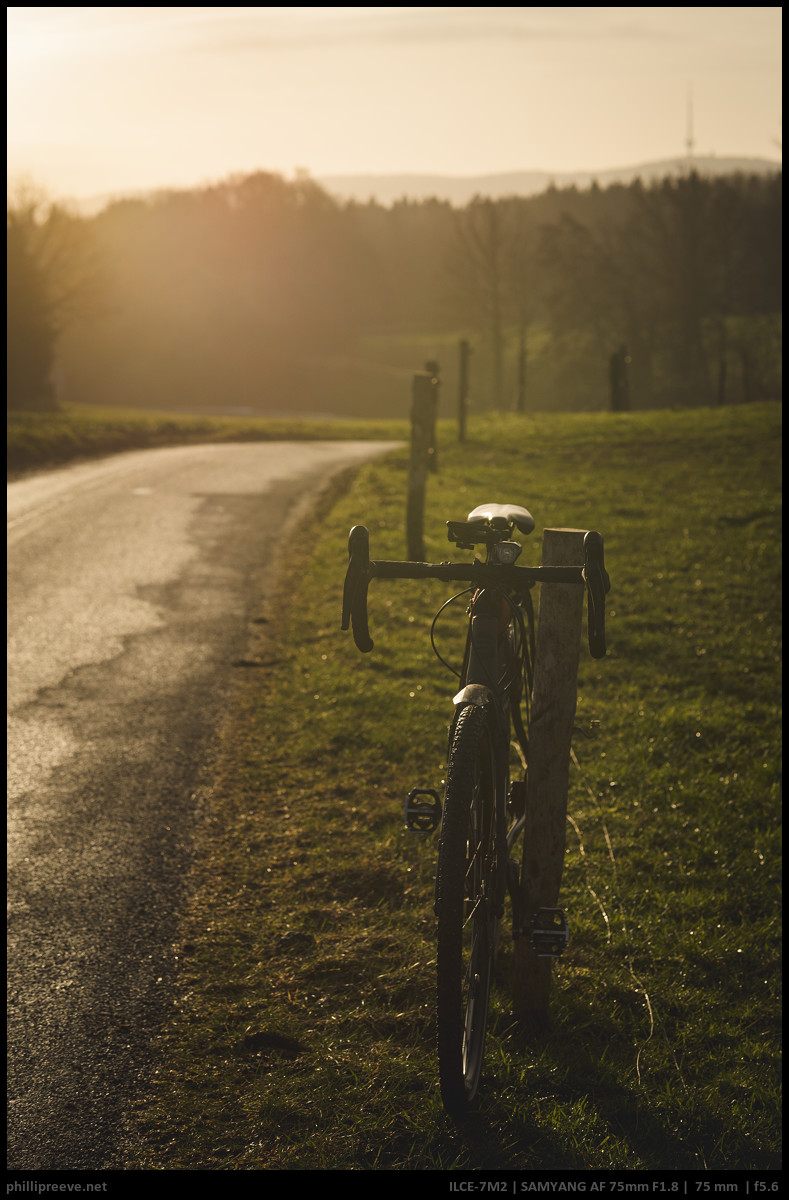
Sunstars
9 rounded aperture blades result in rather fuzzy 18-pointed sunstars from f/8.
Bokeh
- Out of-focus-highlights are rendered neutral with little outlining at shorter distances and some outlining off-center at longer distances.
- Bokeh circles show no onion rings. They take the shape of somewaht rounded nonagons from f/5.6.
- Cat’s eyes are visible but they aren’t very pronounced.
- The transition zone is a bit nervous.
In most scenarios you can expect rather smooth bokeh from the Samyang AF 75/1.8 FE but in more difficult scenarios with high contrast background at longer distances bokeh can become somewhat harsh. I would rate it a little smoother than the FE 1.8/85 but the big 1.4/85s from Sony, Samyang or Sigma also handle long distance bokeh better.
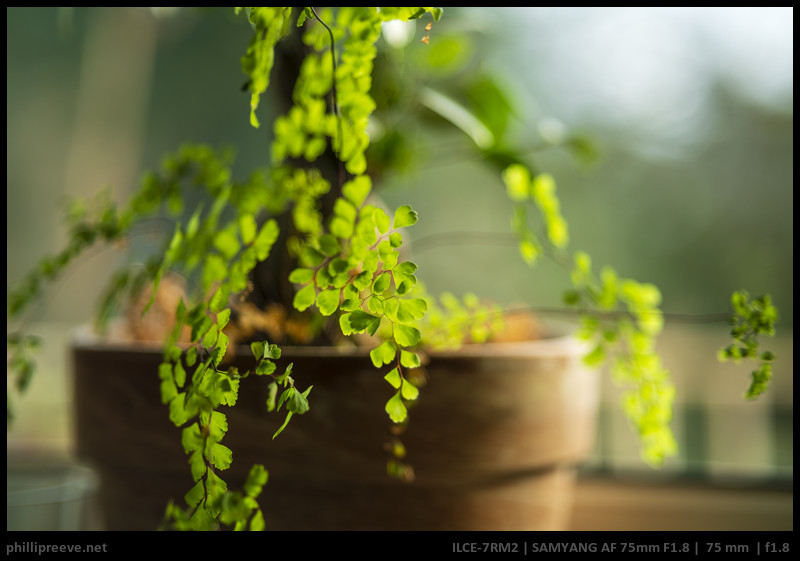
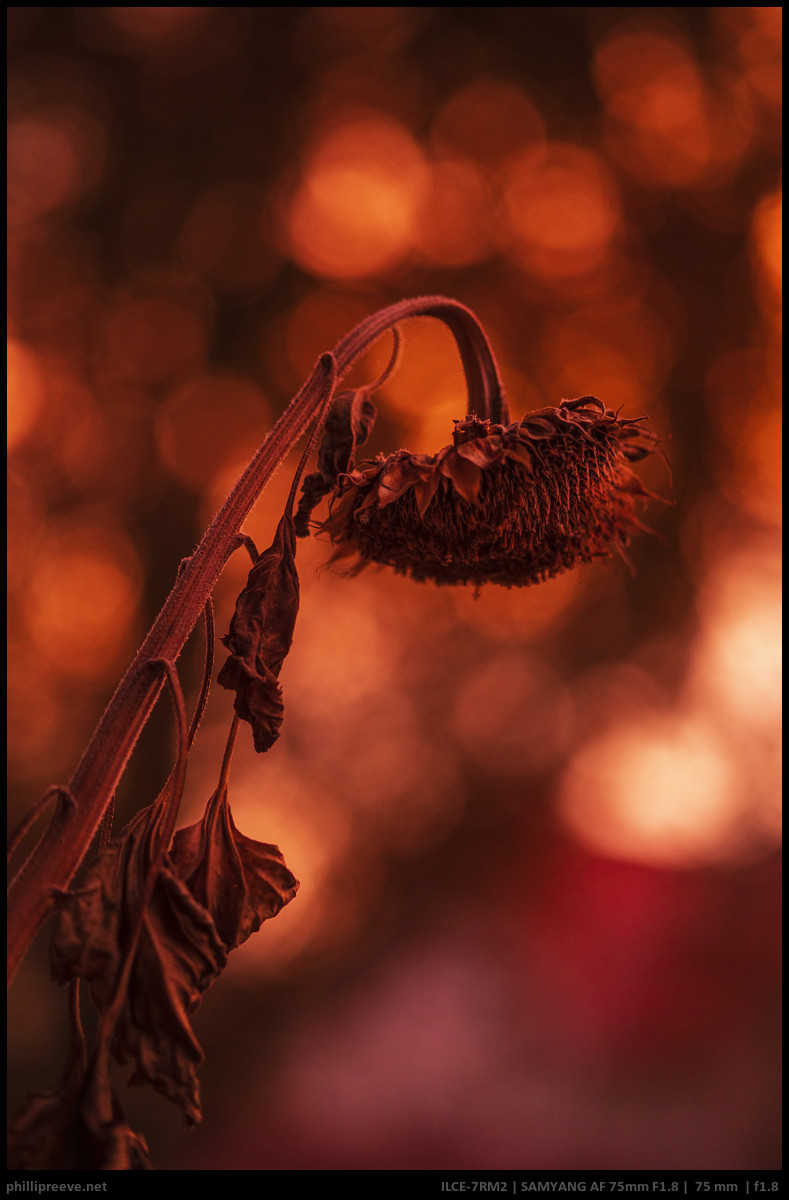
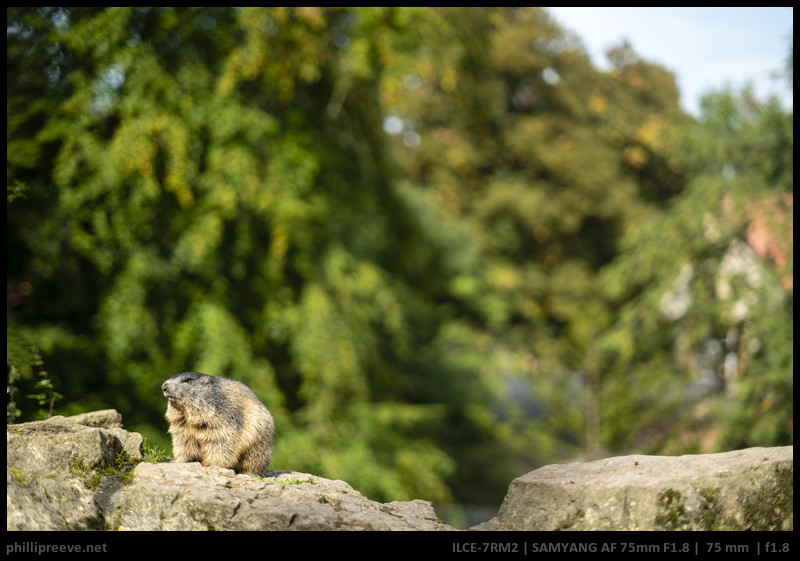
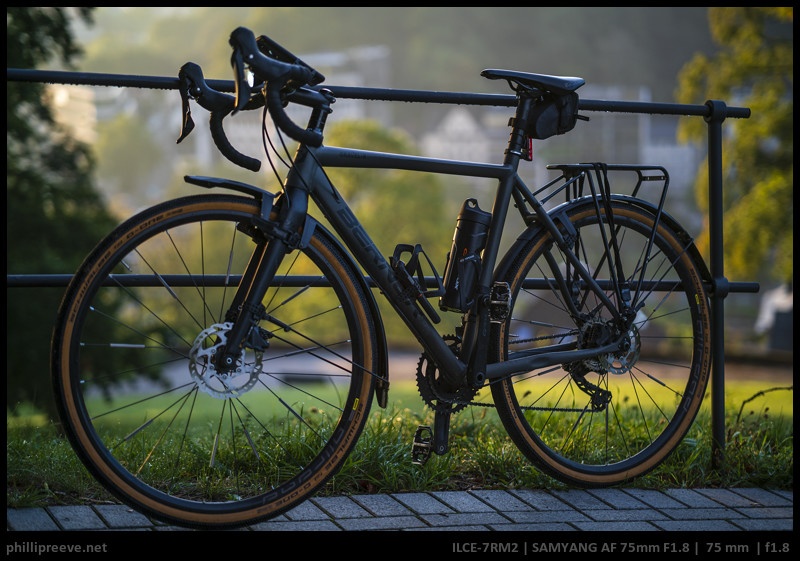
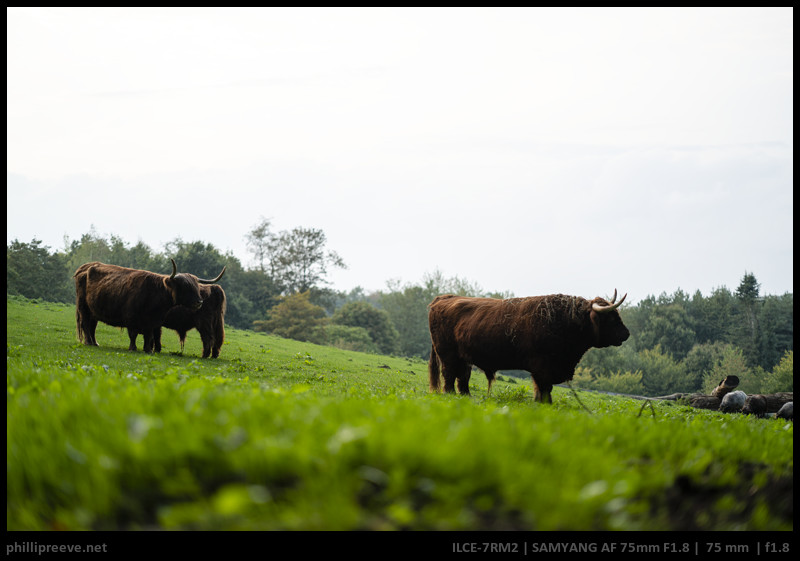
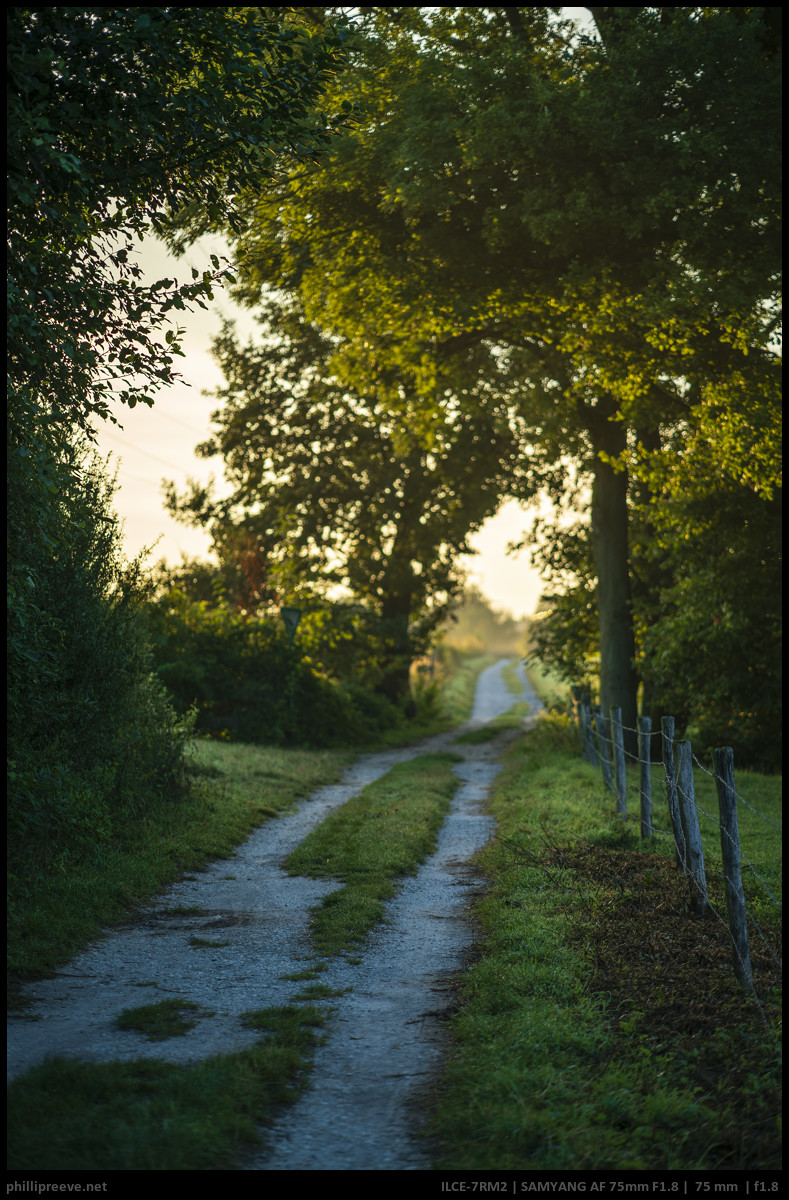
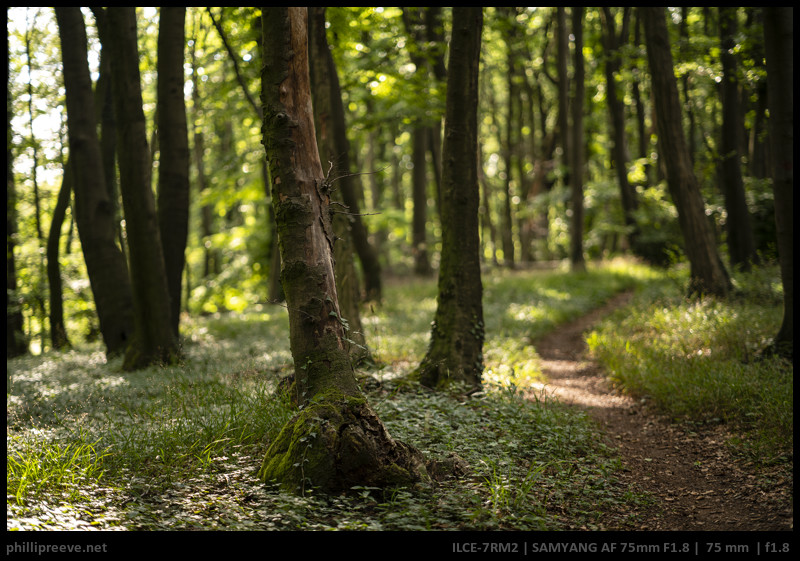
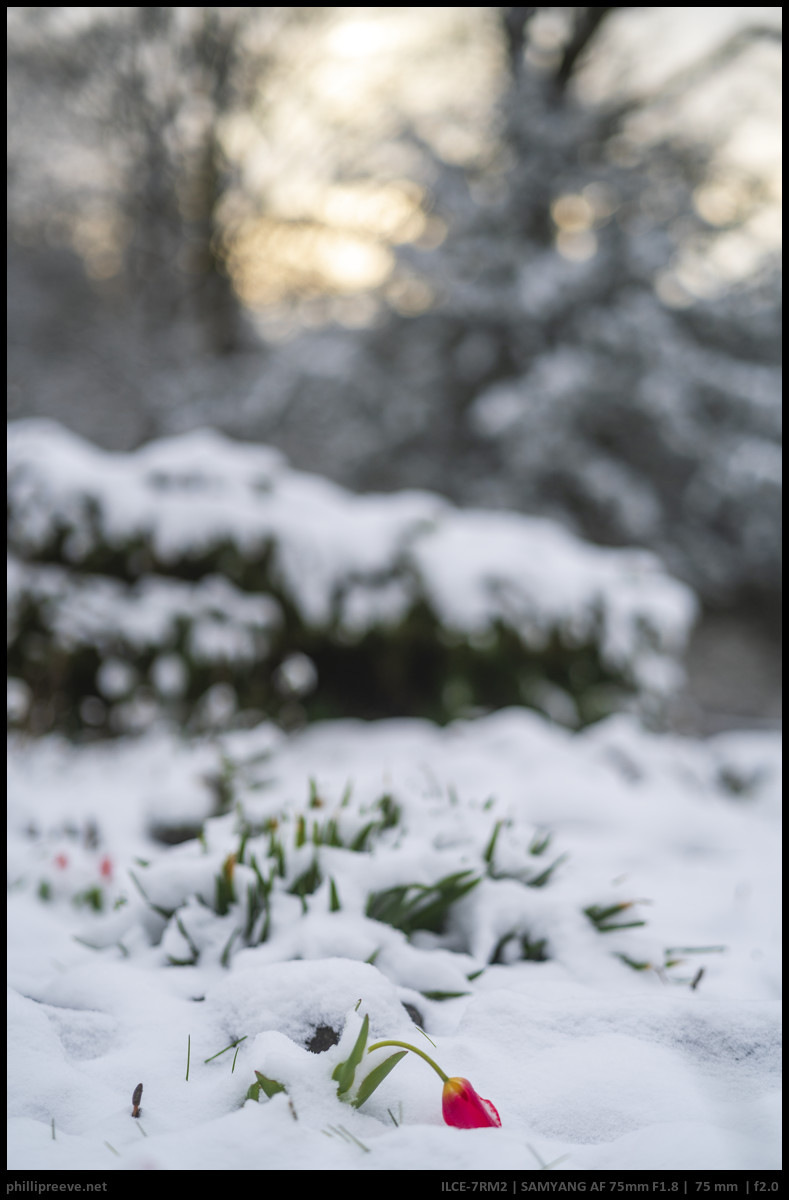
Chromatic Aberrations & Focus Shift
Axial CA is quite well corrected from f/1.8 so you see only minor color fringing. Extrapolating from other fast 85s like the Sony 1.8/85 I would have expected significantly stronger color fringing, so this is a positive surprise. If we look at the construction of the little Samyang 75/1.8 then we see that it is a 10 elements design with 3 ED and 2 high refractive index elements. The Sony 1.8/85 for example only uses one ED element and most classic 85mm lenses don’t use a single one.
Since I use LR correction of lateral CA is corrected by profile and I can’t turn the correction off. It isn’t corrected that well though and some CA is still visible.
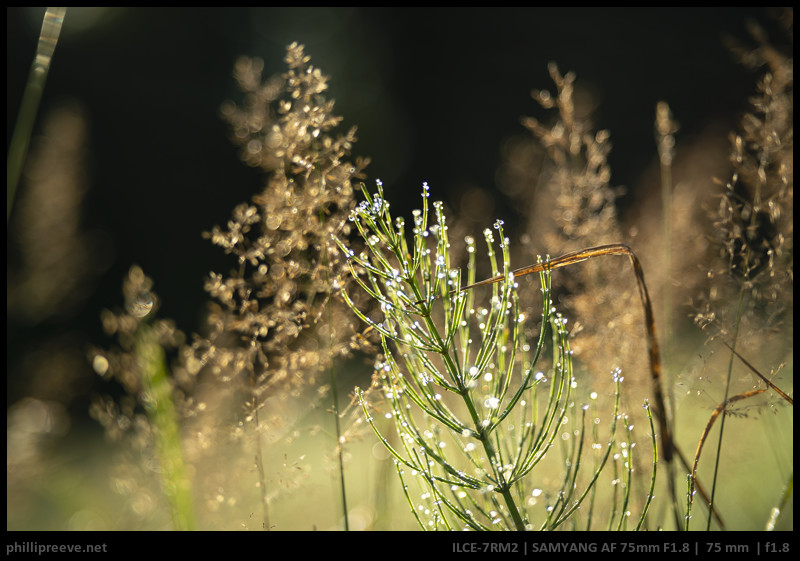
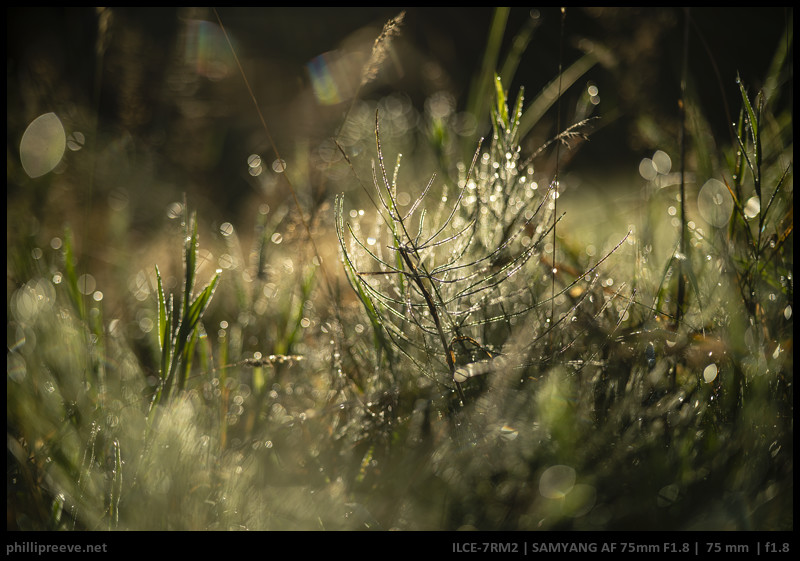
xVignetting
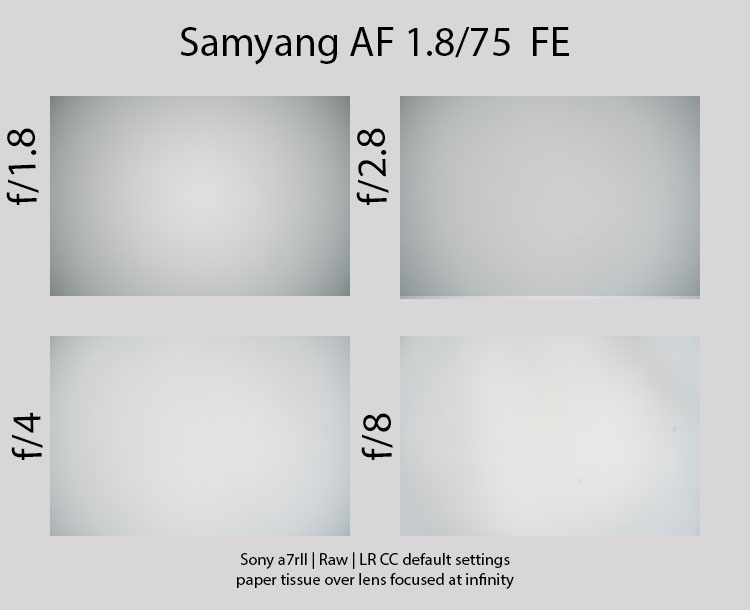
| aperture | vignetting |
| f/1.8 | 1.9 |
| f/2.8 | 1.2 |
| f/4 | 1.0 |
| f/8 | 0.5 |
Vignetting is average for a 85mm lens at 1.9 stops wide open which is reduced to 1 stop at f/4.
Distortion
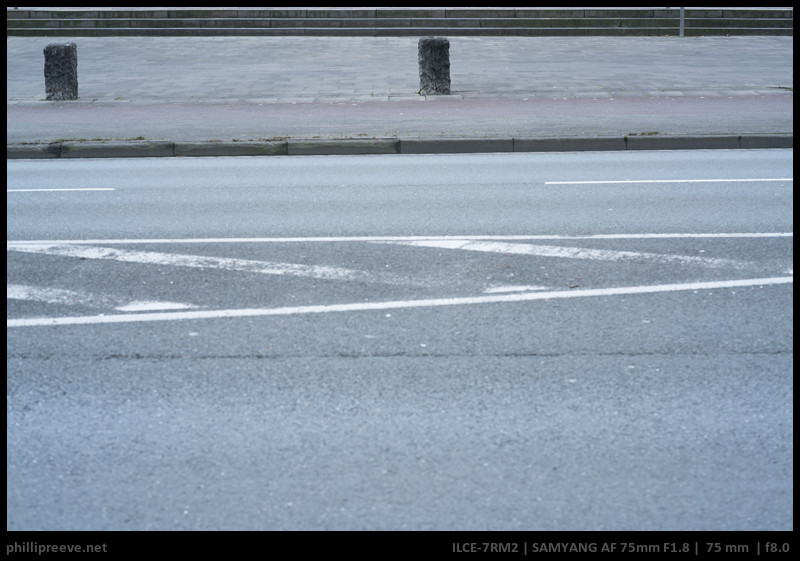
The little Samyang shows a very minor amount of distortion.
Sharpness
infinity

At infinity the Samyang AF 75/1.8 FE is very sharp in the center from wide open but then sharpness quickly drops off as you move towards the corners. By f/2.8 you can get most of the frame to be very sharp but the corners take f/8 to reach very good territory and the extreme corner even benefits from f/11.
Portrait Distance (2.25m)
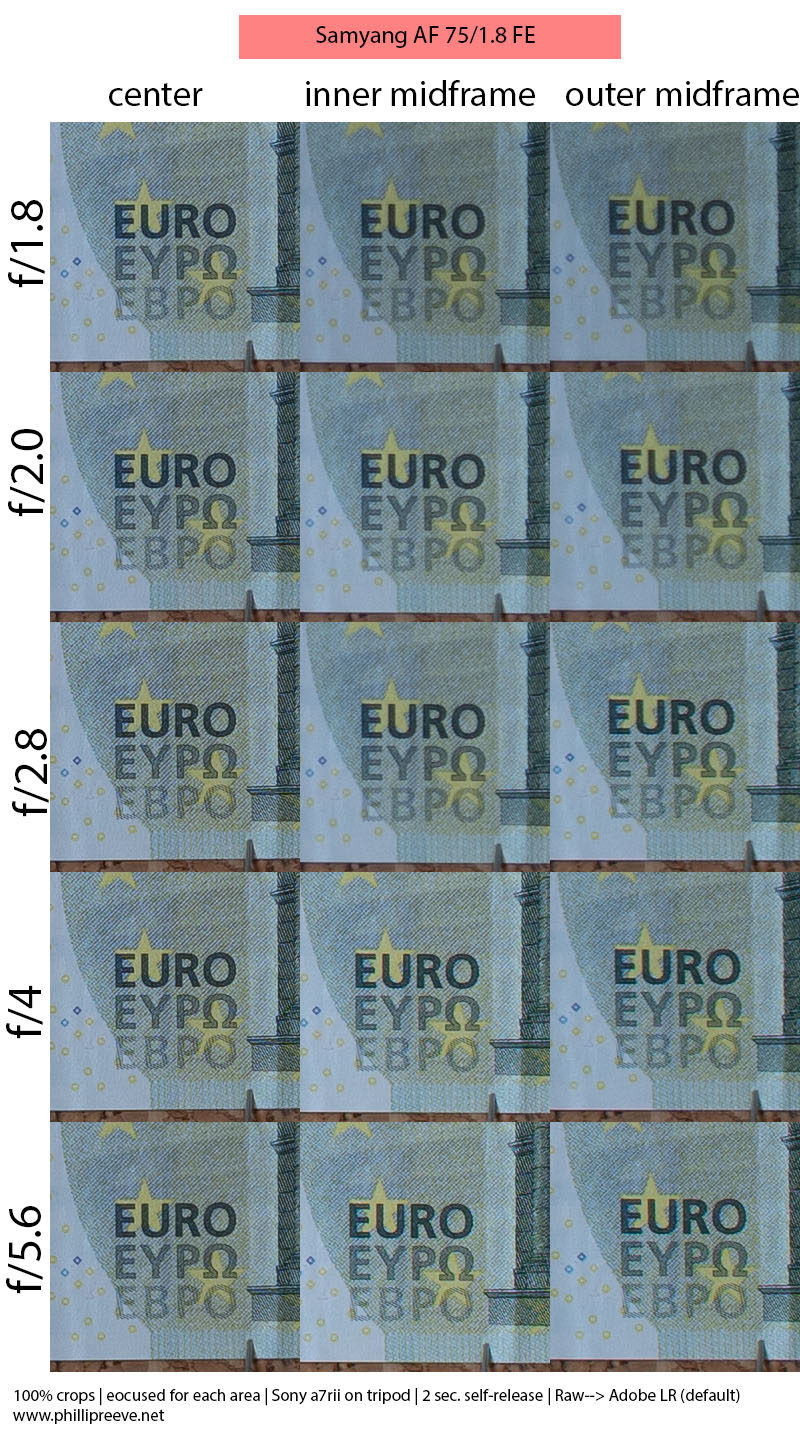
At a little over 2m distance sharpness in the center is excellent and the midframe area is very sharp as well so you can put your subject everywhere in the frame and expect very good results.
Conclusion Sharpness
The Samyang AF 75/1.8 FE isn’t a lens where you can shoot at any aperture and never worry about sharpness. For landscapes you should stop down to f/8. For portraits you generally can place your subject everywhere if you are ready to live with good but not excellent results. Overall where it matters the little Samyang delivers a very good performance.
Alternatives
The Samyang 75/1.8 is the only native 75mm prime in the system at the moment which makes it a bit difficult to define alternatives.
Sony FE 1.8/85: The Sony is $200 more expensive when bought new and maybe $150 more expensive when bought used. It is significantly larger and also 140g heavier but it feels a little nicer and you don’t have to worry that much about decentering. Optically the Sony has a little sharper edges at wider apertures but it is more CA-prone and has less smooth bokeh. Both have below average flare resistance. Also 85mm fit better into most kits but that depends on your other lenses and some will prefer a 75mm lens.
Yongnuo 85mm F1.8: Priced even cheaper than the Samyang the few reviews I found show decent optical quality for portraits but only ok corners stopped down but there were some reports of AF reliability issues.
Sigma 65mm f/2 DG DN: The nearly twice as heavy Sigma is $300 more expensive but build to much higher standards and it is also sharper off-center and even better corrected for CA.
Voigtlander 75/1.5 VM: The 2.5 times as expensive Voigtlander is a fully manual M-mount lens with build quality of a different league. At least on E-mount I would rate the Samyang as the better portrait lens while the 120g (180g with adapter) heavier Voigtlander is the superior landscape lens.
Samyang 1.4/85: Samyang‘s other portrait lens is sharper and smoother in bokeh but also larger and more expensive.
Conclusion
pros
|
average
|
cons
|
The Samyang AF 75/1.8 FE is certainly tiny. But is it an absolutely great performer? Of course not, the several times as heavy 1.4/85s are technically better lenses. But especially for its size it is a very capable lens which delivers generally very good optical performance on par with for example the Sony 1.8/85 FE. It is sharp where it matters, CA ist well controlled, bokeh is mostly smooth and flare resistance is the only real issue I could find. Unlike with other Samyang lenses there are also no big handling issues.
Given the low price this performance is remarkable. But of course there are a few trade-offs which come with the low price, namely high copy-to-copy variation as I experienced first hand and a bit lower build quality. Overall though the Samyang AF 75/1.8 balances size, price and performance surprisingly well without any mayor shortcomings. So if you are looking for a small lens which gives you a lot of bang for your buck, then I can recommend the Samyang AF 75/1.8, especially if you can integrate a 75mm lens into your kit. Make sure to test it though before you keep it.
The Samyang 75/1.8 has a recommended price of $399. Check current prices at amazon.com, B&H or ebay.com. In Germany the recommended price is 399 €. Check at amazon.de.
If you purchase the lens through one of these affiliate-links I get a small compensation with no additional cost to you.
More Image Samples
Most images in this review can be found in full resolution in my Samyang AF 1.8/75 FE flickr set. There you can also browse samples in a very high quality browser.
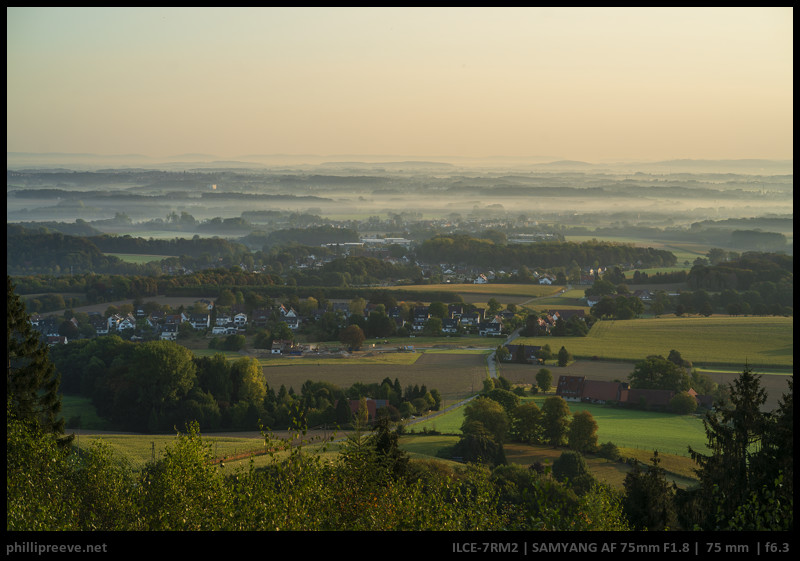
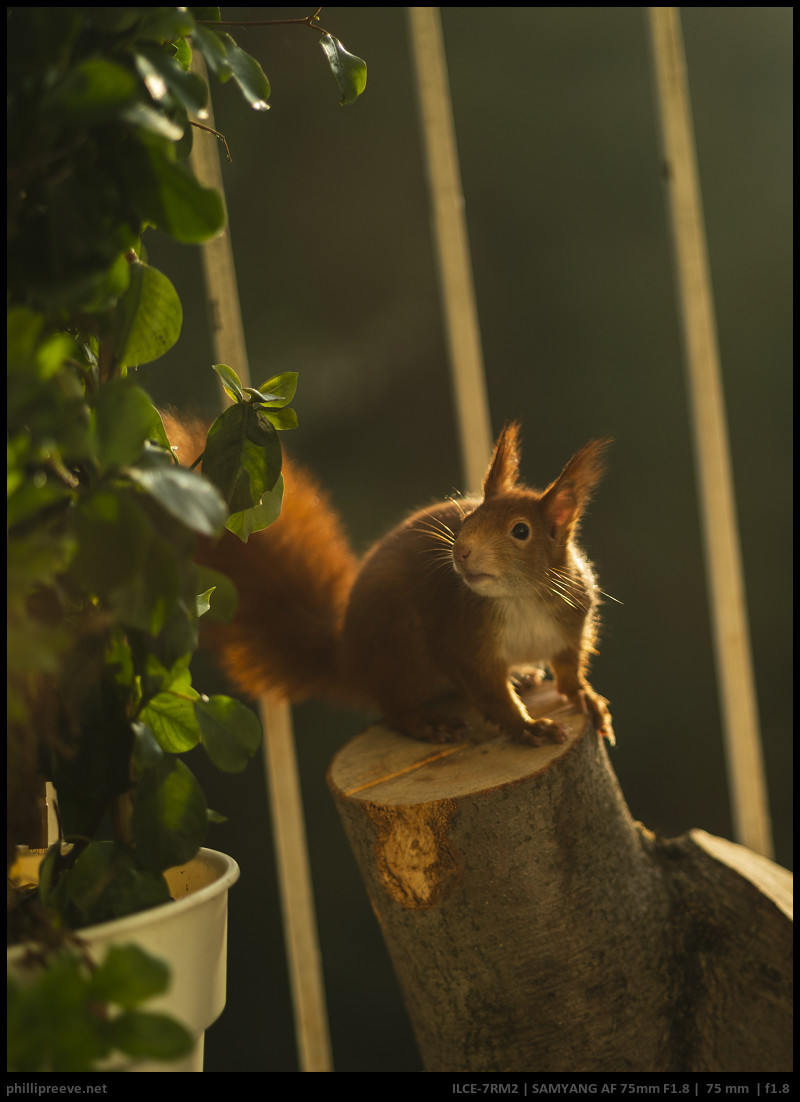

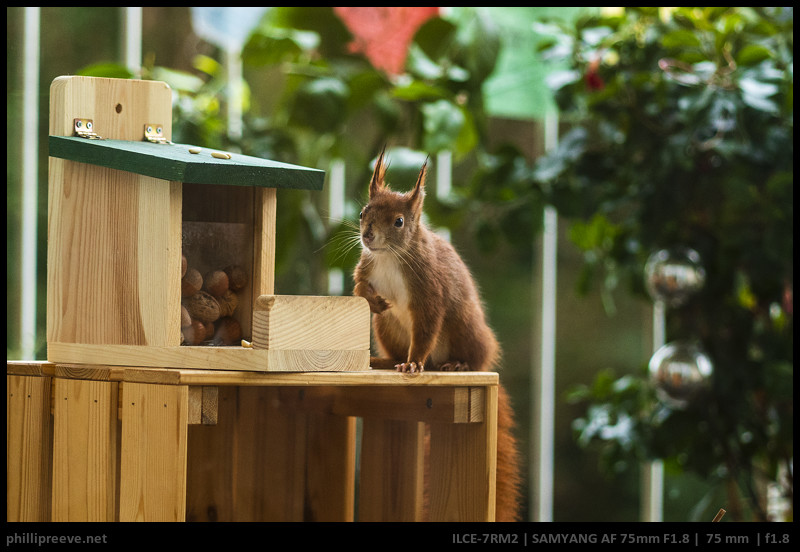
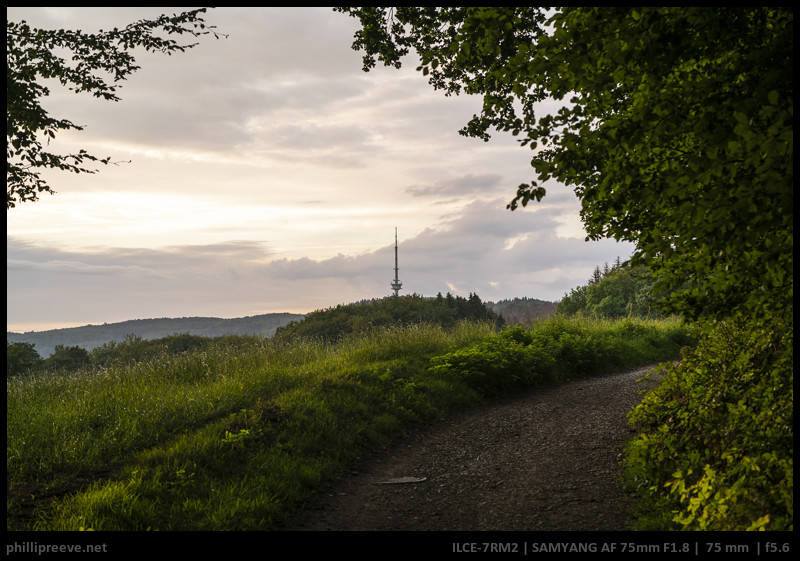
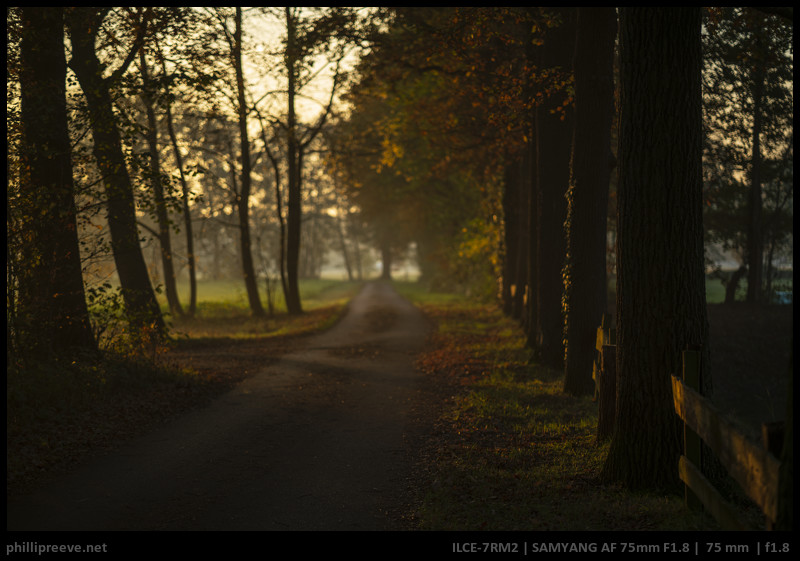
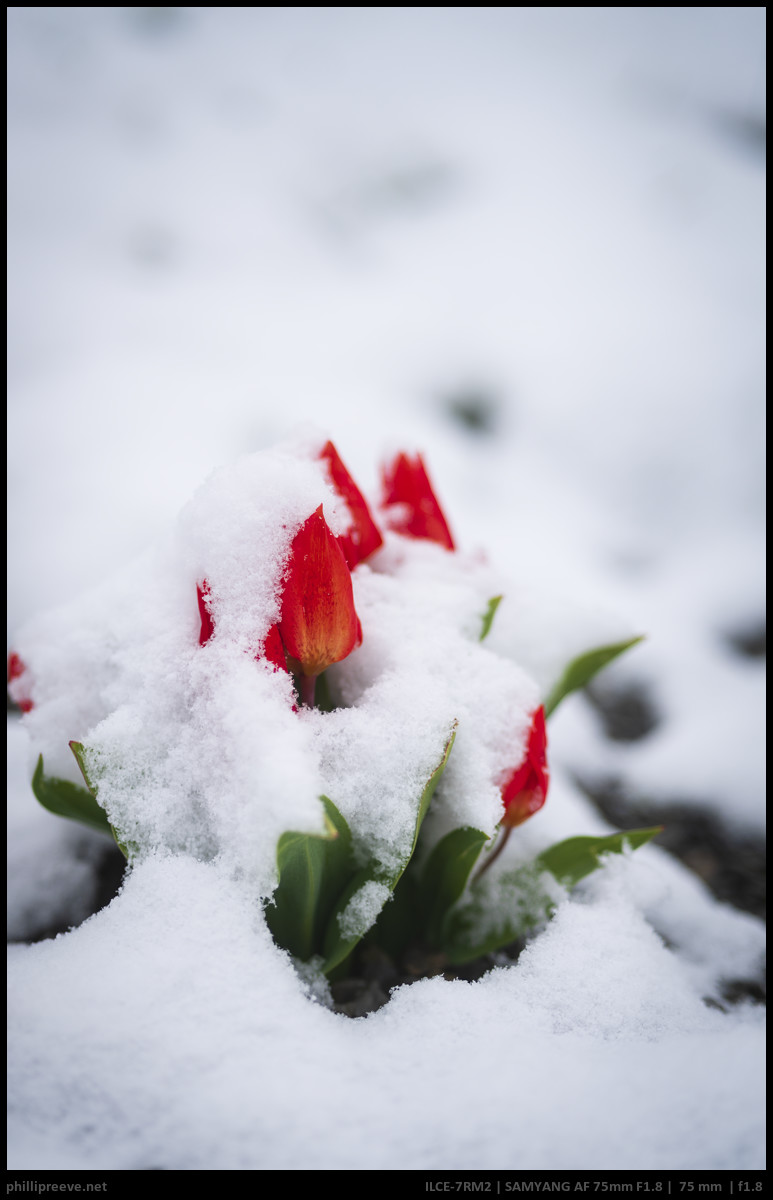
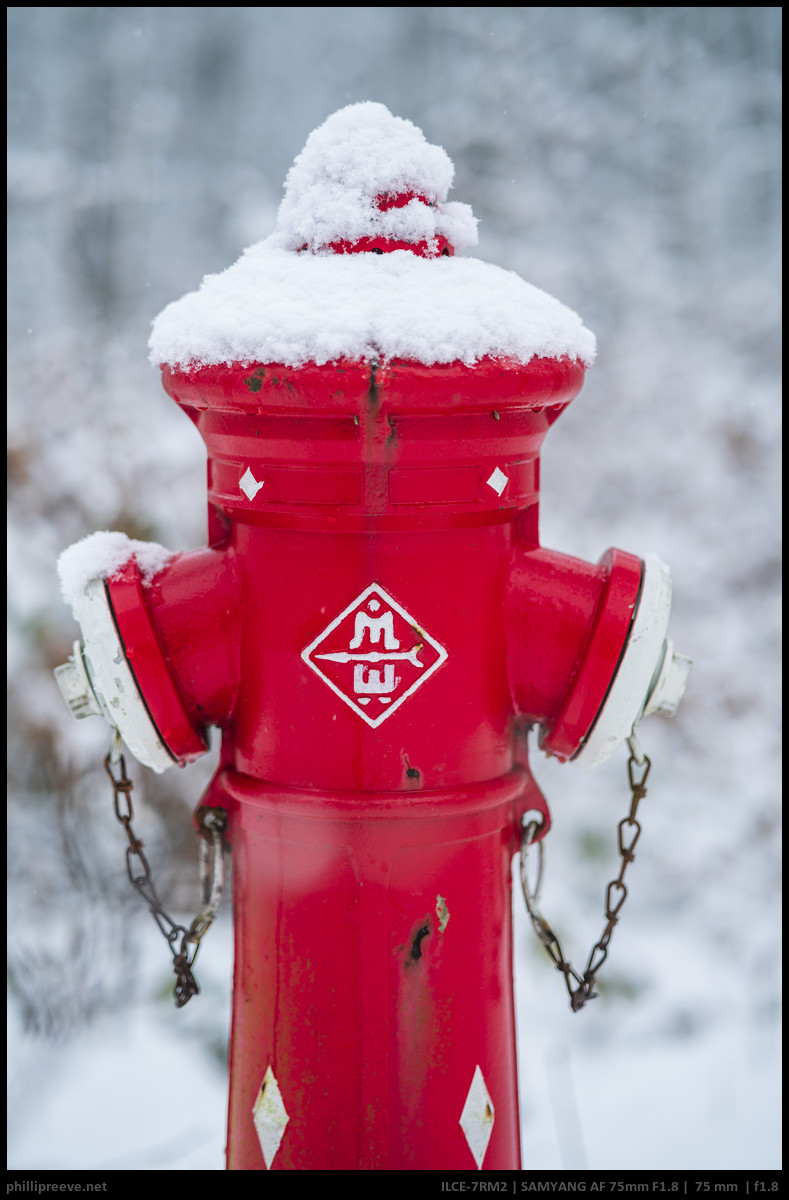
Other articles
- The best lenses below $499 for the Sony a7 series
- Sony FE List
- Guide to the best Portrait Lenses for the Sony A7 series
This site contains affiliate links. If you make a purchase using any of the links marked as affiliate links, I may receive a small commission at no additional cost to you. This helps support the creation of future content.
Latest posts by Phillip Reeve (see all)
- Review: Samyang AF 75/1.8 FE - April 12, 2021
- The FE-List now has 113 lenses on it - March 25, 2021
- 2020 – Year’s end review - December 28, 2020
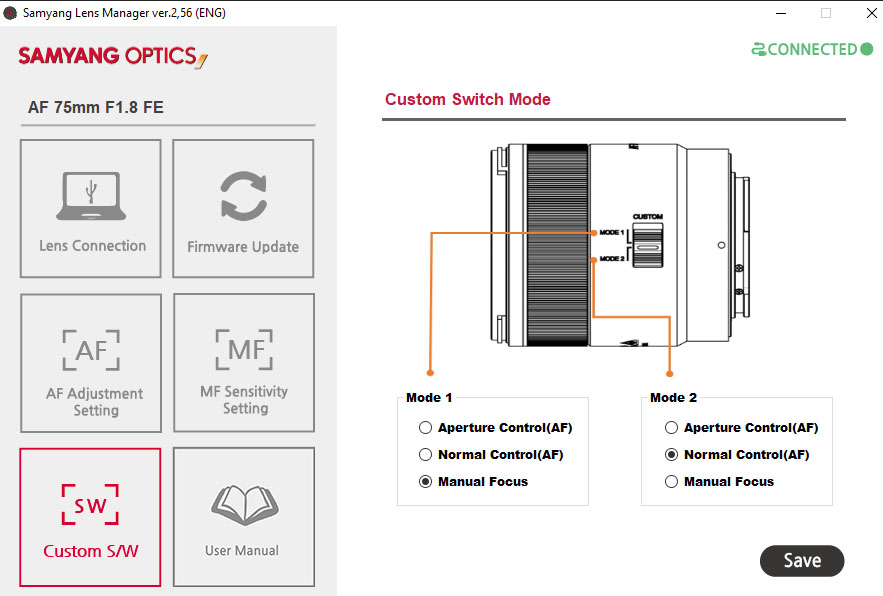
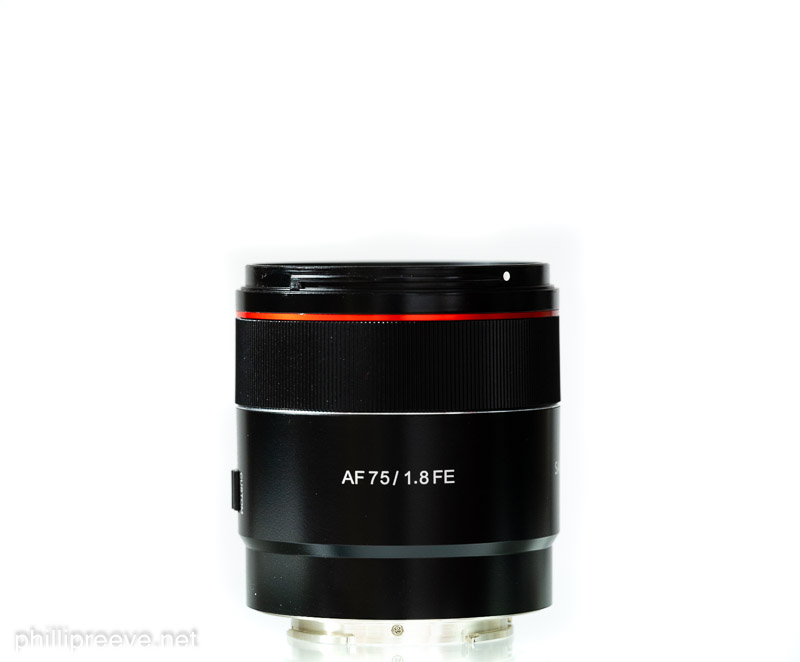


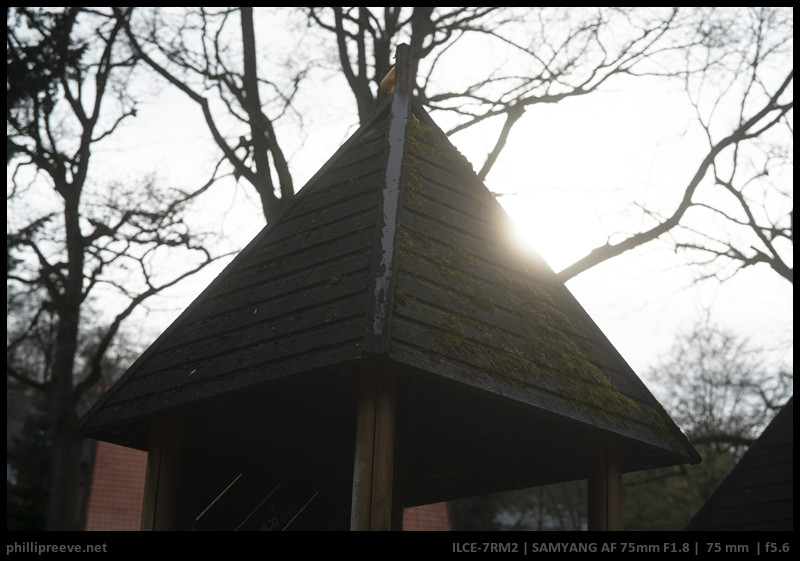
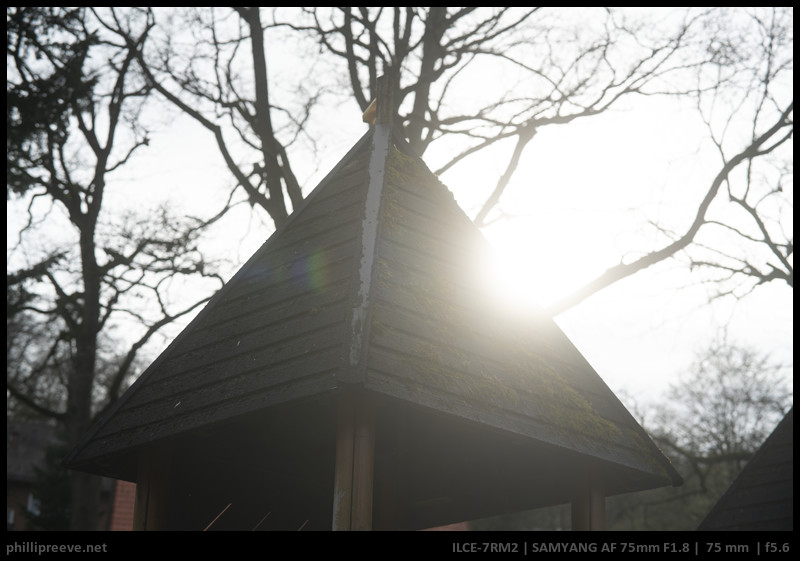
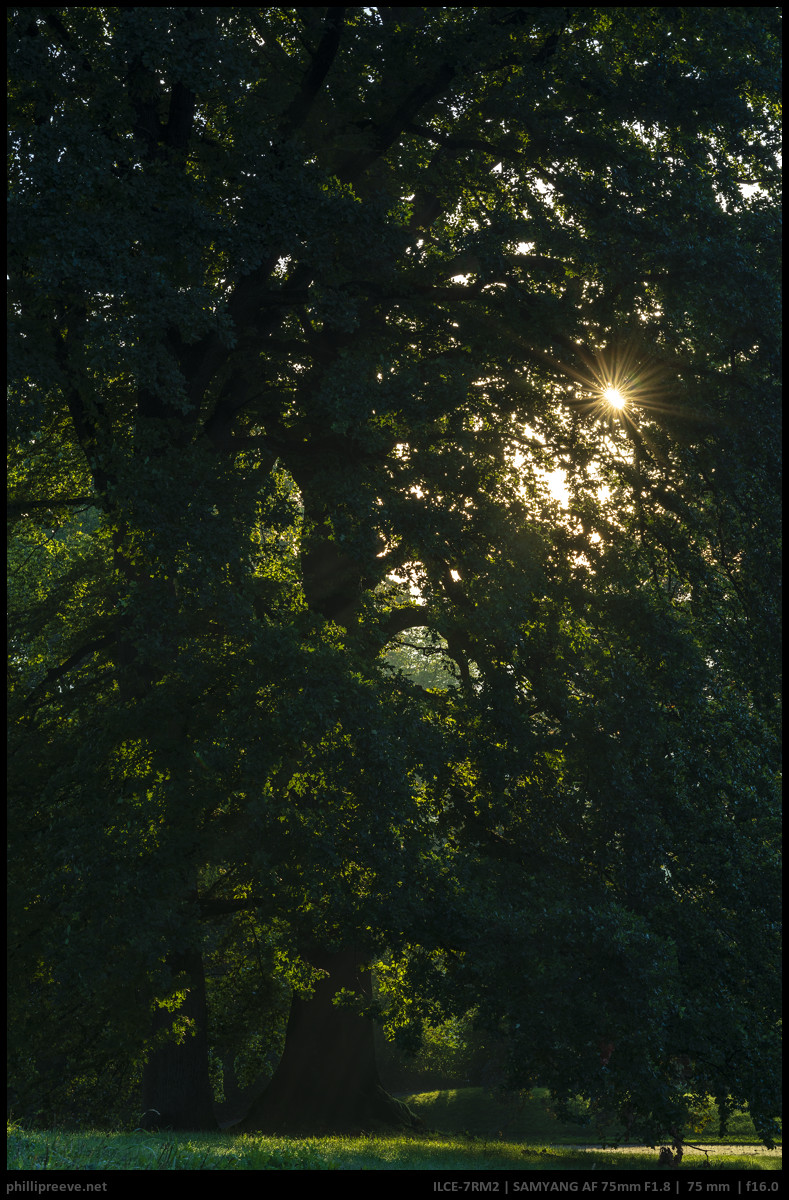
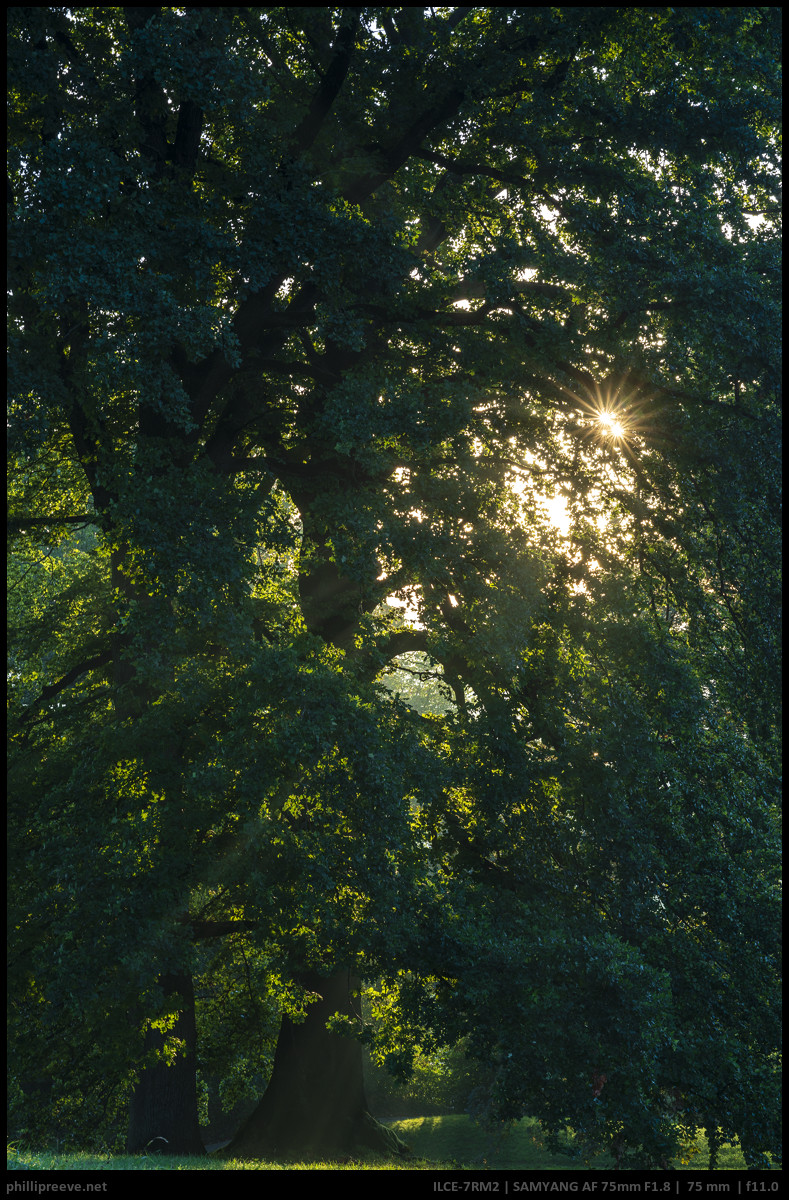
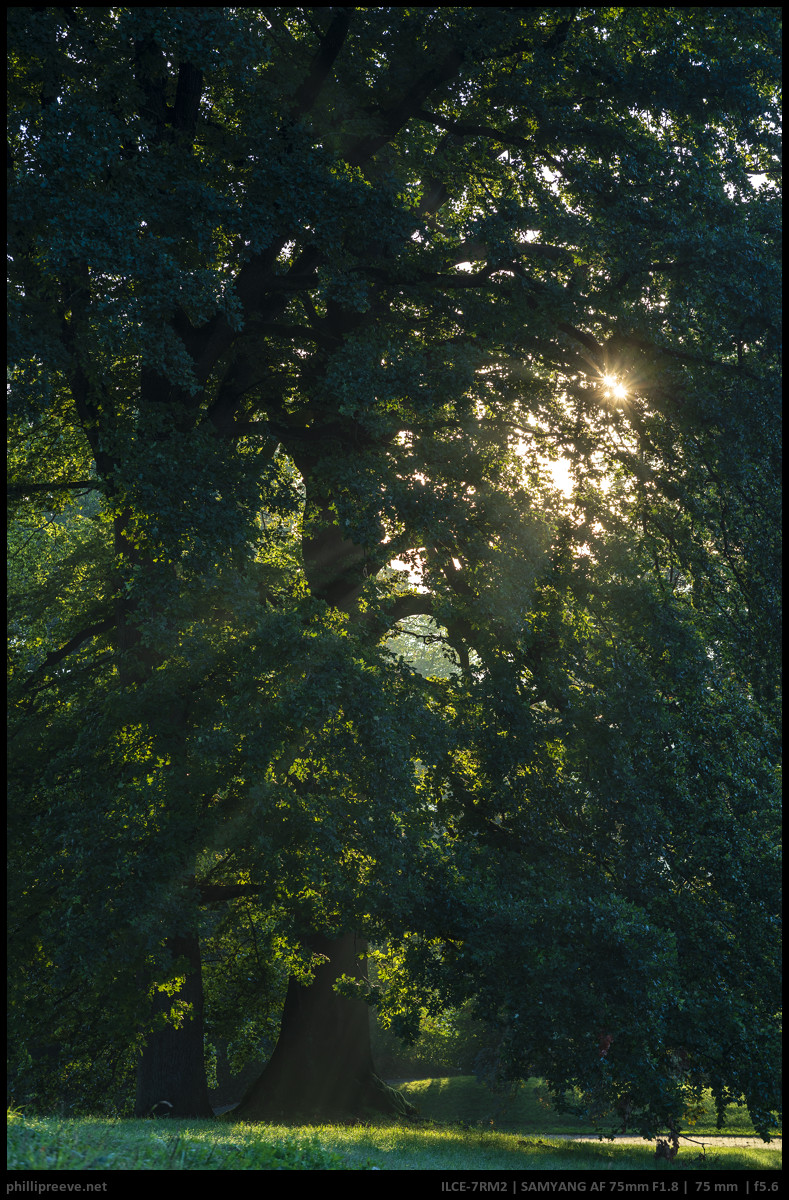
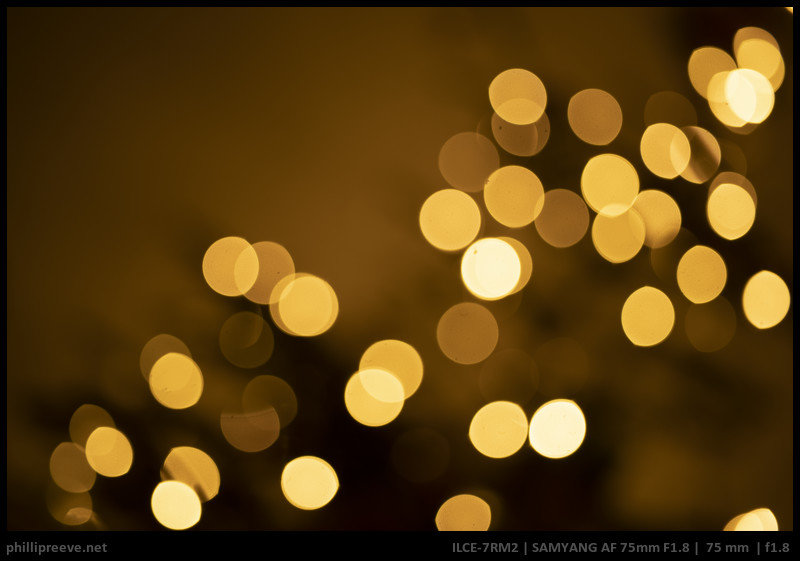
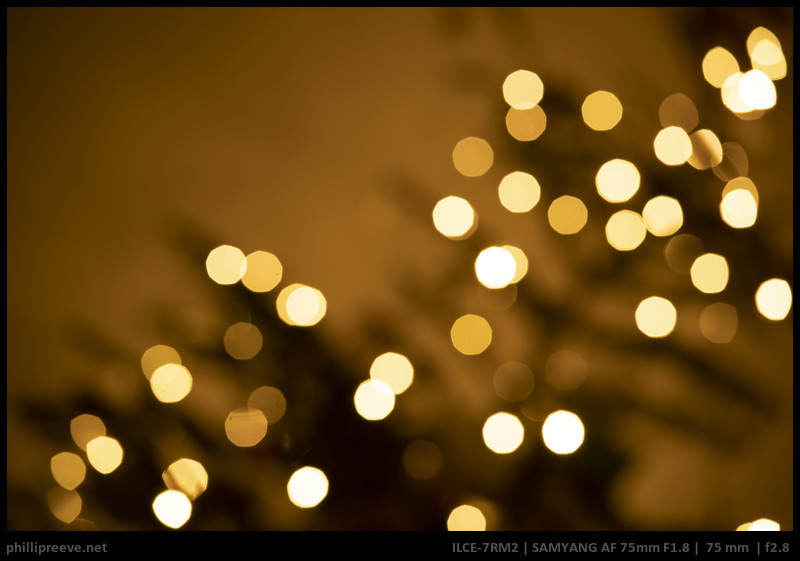

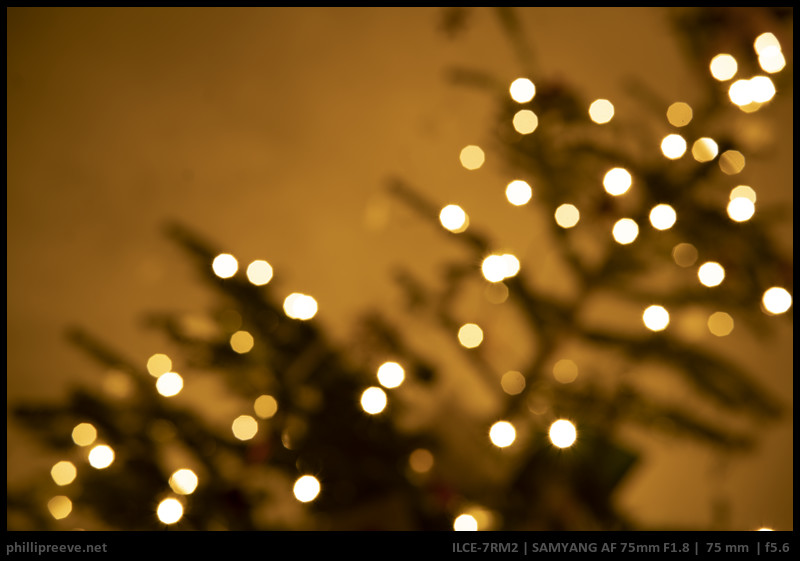

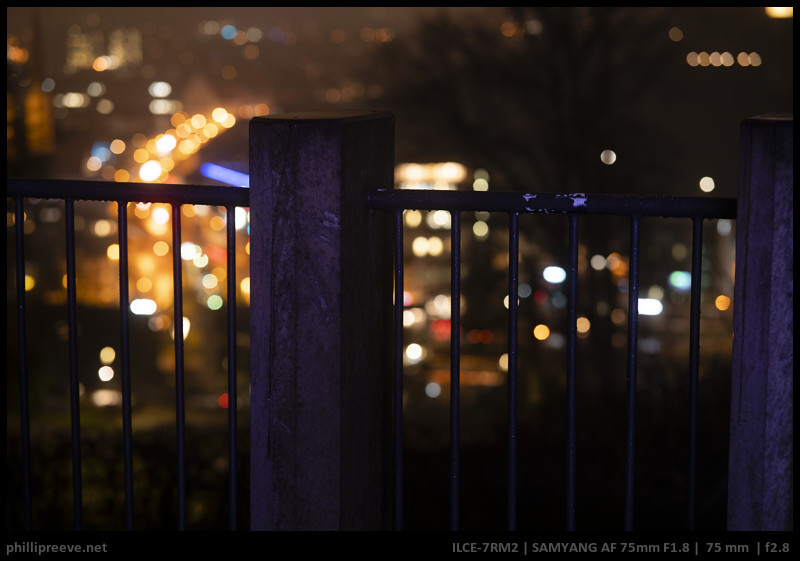
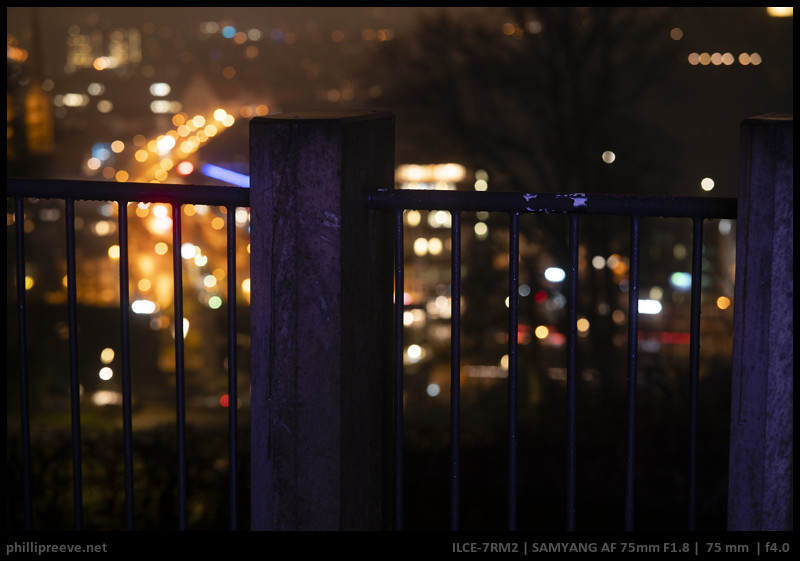
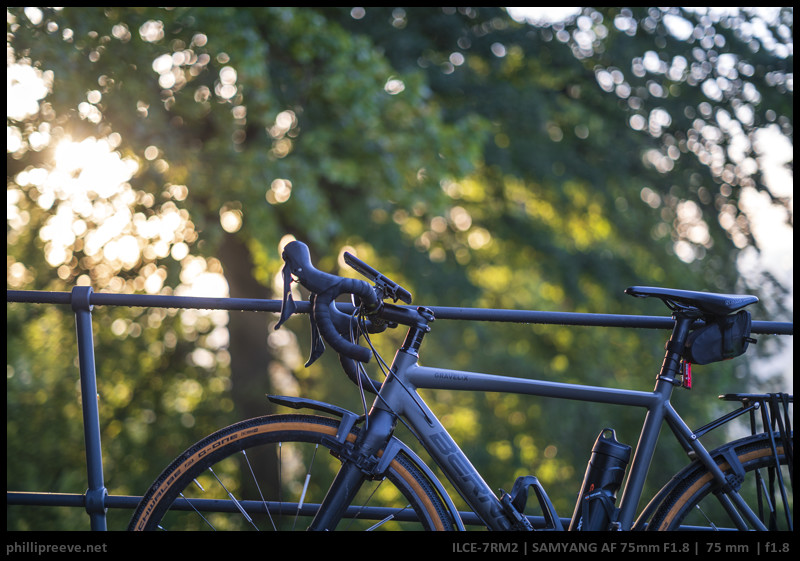


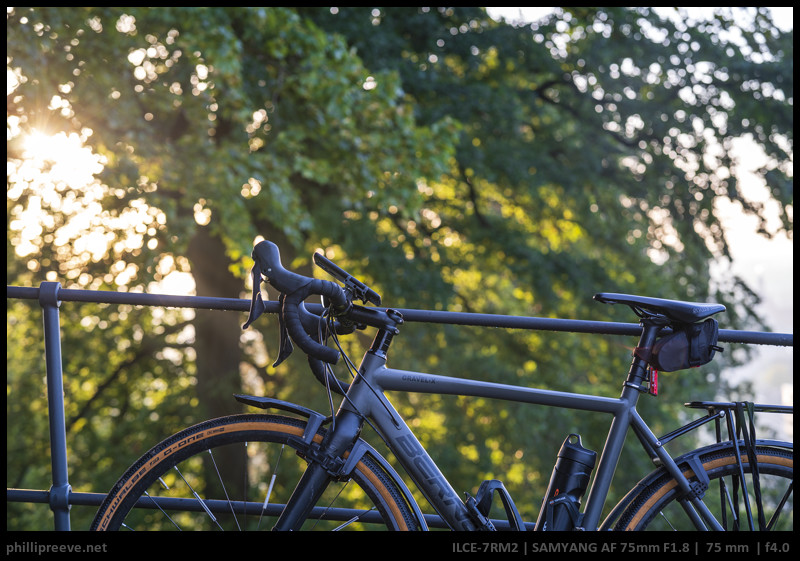
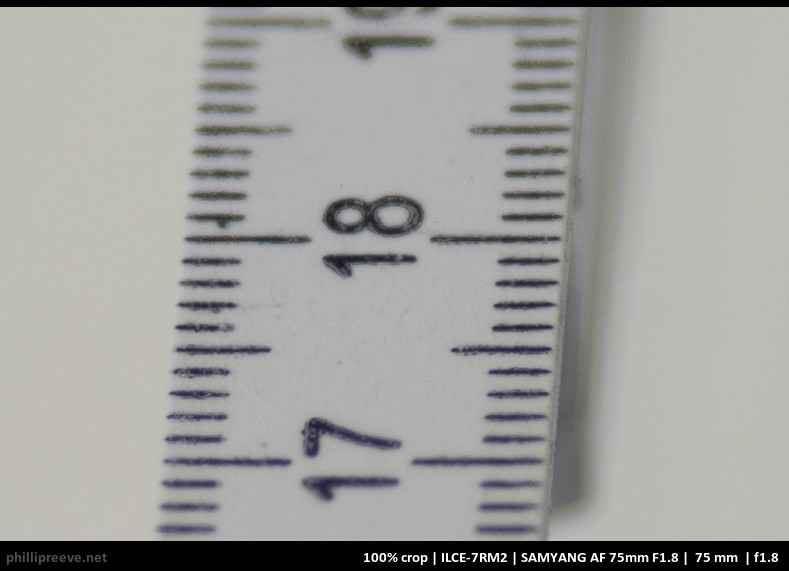
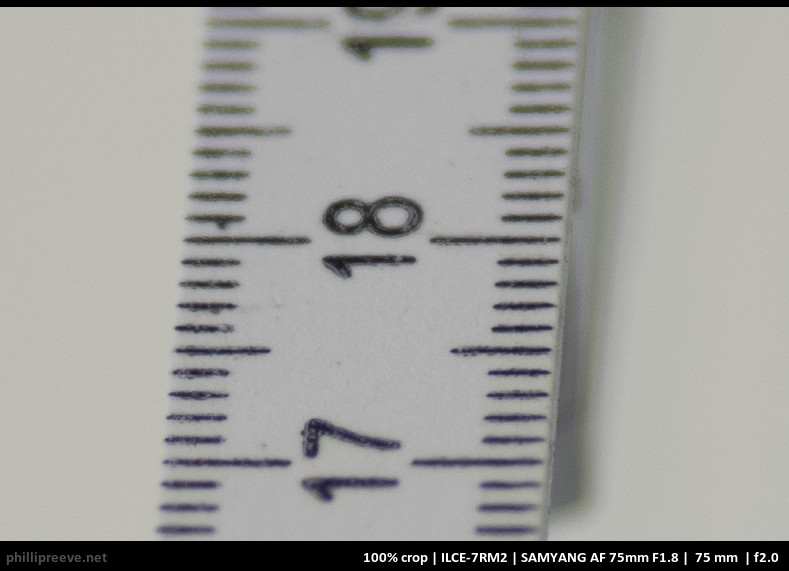
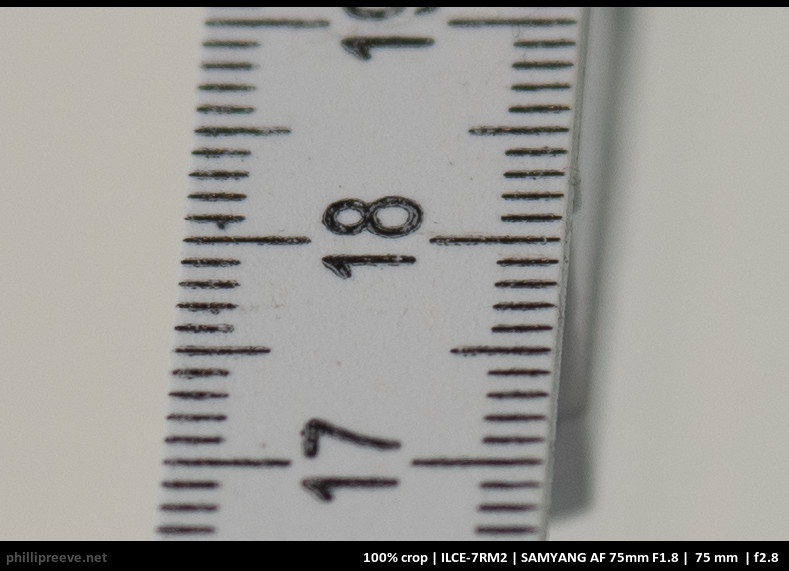

Nice review, I have this lens and like it a lot. Haven’t used it much for landscape work yet, more like hundreds of snapshots of my daugther ^^
Regarding the option to tweak autofocus using the dock: I found that it’s not necessary with the 75mm, but I had to play around with the settings with the Samyang 18mm 2.8 to get reliable autofocus performance. For some reason my copy tended to front focus even though the camera thought focus had been achieved. I have no idea why and how, but before I adjusted it using the dock there was a 50/50 chance pictures would be misfocused.
Samyang teased that “more options” would be coming for the custom switch, but nothing as of yet…
thanks for the review of an interesting lens.
Since corners take a while to get sharp i wondered if you have checked for field curvature. Could it be that corners get sharper if you focus on them (or for best ovarall results on the midframe)?
eh, would rather buy 2 or 3 decent vintage portrait optics with the $400. Nothing really notable or impressive about this lens imo …
I think we have sufficient evidence to establish the following conclusion: “eh”
Like if I looked hard enough I could probably spread $400 across a Jupiter-9, Minolta 100/2.5, and Nikkor ai 135/2.8. Each of which would be more desirable for portraits 🙂
Currently it is $299 new and about $230 used but yeah, if you are fine with manual focus and slower speed then those offer better value and build quality at somewhat larger size 😉
(Eye-)AF is invaluable with kids. It’s cheap so no problem to keep around in addition to vintage portrait lenses.
The children need the microcontrast and the beautiful rendition Stephan! Do it for the children!
There’s not gonna be much micro contrast after my niece runs at me and sticks her fingers on the front element as I futz with MF… I admit I’m a disagree at MF tho.
Microcontrast really depends on the lens though, many classic lenses don’t have much of it shot wide open by design 😉 Thinking of Minolta 85/1.7 for example…
Actually the rendition of this lens wide open is far better than any of the three vintage lenses you mention. It is also considerably sharper wide open, at least near the centre. Add to that, the chances of getting the eye in focus wide open on a moving portrait are about 1000 times higher.
Same here. I need AF for my kids and use this lens mostly on the road combined with a 28mm lens
I just returned a poorly aligned 5 element MC 100 F2.5. I am keeping the Samyang 75.
I guarantee you that you are still way more likely to get a poorly aligned samyang than a Minolta, even if that happened
I’ve owned over a hundred Minolta lenses, have you?
@QuietOC, no, but literally the majority of samyang lenses tested by Phillip have been decentered. On the other hand, even if Minolta has a problem with that, I would be very surprised if more than half of Minolta lenses are decentered, in your experience are most Minoltas decentered or are the majority of them aligned well?
If you buy the Samyang lenses new you can return until you get a good copy. Not as easy with vintage lenses. Many sellers don’t offer returns. And I don’t think it’s the majority. Maybe the folks here have had bad luck but I’ve owned about 6 or 7 Samyang lenses and only 2 were decentered bad enough for me to return them. Most recently, my 35mm F1.8 is a little decentered but only a little and not enough for me to bother returning. My 18mm and 75mm were both fine.
Thank you for another greatly informative review Phillip, it’s always much appreciated. I’m aware of this lens ever since it came onto market and I’ve seen a few reviews, but only now I do have a clear image of what to expect (and in my case why I shouldn’t buy it after all). The weight is quite impressive though, so it’s a shame the lens can’t perform very well as a landscape option (possible decentering aside, and it’s good you always consider that, unlike most reviewers). Still, I can see many will consider it a viable option when AF is a must have, considering the price and direct competition. Who doesn’t mind MF and using a vintage lens will probably look elsewhere (speaking of 85mm lenses of course).
I have this lens, and to be honest I like it a lot. I tried to take landscape (even if that’s not what I usually take) and I didn’t see any issue. Here is an example taken at f5.6. Maybe it is not that good, but to me, it is more than sufficient.
https://www.amazon.fr/photos/share/vSC1huEyzbDU31QdAyG16L2Qwga2R70CAt1s3OLl7pn
I feel you. Today many want small lenses and optically top notch. This 75mm lens is a very good package and compromises. For me an addition to my 85GM when I’m on the road with my family.
I would disagree with the sharpness conclusion. I originally got the same result, but after I setup the AF adjustments, I found that if I set a large negative value, the effect is not to pull the focus point, instead, it corrected the curvature. After set it to -4 or -3, it improved much on the corner sharpness.
The extreme corners are totally usable after the adjustment. I did the same to 45/1.8, and got the same effect.
So you use it as it is for portraiture, and adjust AF to minus 3-4 for landscapes, to correct for field curvature in the corners?
youre correcting field curvature with a slight shift in focus calibration? Have you tried focussing at midframe/corner instead to handle this issue?
I didn’t notice any focus shift. Actually I was disappointed that the AF adjustment didn’t work at first. Then I noticed the corner sharpness changed when shooting the flat test chart focused at the center. All in latest firmware.
Thank you again for this new and interesting review.
Among the alternatives I think it should be also considered the Ttartisan 75mm. I mean I would consider it if I am interested in a short tele portrait lens.
One more question: do you think the sensation given by the focusing ring (used to change the aperture) is close to the aperture ring of a new lens like a Sony or Sigma? And what if compared with a mechanical aperture ring?
It’s nothing like a mechanical “clicky” aperture ring, but it’s quicker than the camera scroll wheel.
The 7artisans 75/1.25, besides the focal length, is nothing like this lens – it’s harder to focus at 1.25 of course and not as sharp when used at mid distances.
No it’s not the same feeling Compared to other Sony or manual lenses. No way. Usable but nothing more.
This 75mm has AF and f1.8 plus Lightweight and small size. Cheap also. And no AF competition. It’s a good everyday 75mm F1.8 AF street lens. (in my opinion).
I’ve had this lens a couple of months now.
My first copy was slightly decentered, at a level where I was undecided whether to send it back, but I did. Second copy was better, though not as “perfect” as some (I use the same longer distance test procedure as Phillip & Co.).
Regarding the sharpness tests, the corner results seem to be much worse than those I get from my sample. I’d say that my f/1.8 extreme corners look more like the f/2.8 or even f/4.0 corners in Phillip’s test.
I should mention that I have a (n overly) huge number of 85-105 mm lenses, many of them Leica, Zeiss, ect. and, sharpness-wise, the Samyang does as well or better than nearly all of them. The 85 Loxia, CY Zeiss 100 3.5 and maybe a couple of others do better at equivalent stops, but I consider the Samyang’s performance in that aspect to be very high indeed.
I suspect that the PDAF on the sensors has the same problems of DSLR PDAF and that’s why an AF Micro adjustment is necessary . I tried a MF Pentax 28 2.8 with a chipped PK to Eos adapter (which is not programmable and always backfocus on my 5DIII) on an R6 and guess what….. although the PDAF MF assist was spot on I had back focus.When I use the CDAF assist of the camera (focus picking) the lens was spot on , pin sharp. That’s my findings.
Excellent review, as always. You may want to change the Flickr link though, as it currently leads to the Samyang AF 35/1.4 FE album 😉
Great review! Looks like there is indeed some sample variation with this lens. My sample is noticeable more sharper that yours, roughly it performs on 1.8 as yours do on 2.8 (maybe even f4). On the other hand, I often have more LoCa than you have on the sample image with snow.
As far as AF correction through the dock, I’ve read about it, and suggestion by Samyang is not fiddle with it unless really necessary. Every lens is calibrated differently from the factory, ie mine is at – 1 and it performs great.
I find all lenses from Samyang “Tiny but mighty” series pretty good IRL, and this one is among my favorites. It’s complements very well with Tamron 28-200 to get really compact kit that covers 99% percent of my casual needs. If I had a magic wand, I would make bokeh more neutral in high contrast situations and I would reduce the amount of LoCa.
mind sharing a few high resolution samples?
Hi Phillip,
I just did a corner comparison shootout between the Samyang and a few good “usual suspects”.
I don’t have a hosting site, so how can I get the files to you?
Would you like them full frame or should I crop the corner details?
cool!
Any cloud hosting service like google drive, onedrive or dropbox would be fine 🙂
This is the closest to infinity shot at 1.8 that I have at the moment. It’s not exactly infinity, it’s more like 80m (focus is on the house among the trees)
https://1drv.ms/u/s!AnSVSTXdg6CWhqxo085PE9SePIg2uA?e=35s38d
And this is one of the LoCa examples (focused at around 20m)
https://1drv.ms/u/s!AnSVSTXdg6CWhuEMT_W_M6-U-RiYDA?e=2FCN1s
Few more examples from my side, this time on 42mpx body (A7R III). This one is the same composition as with the previous example, the focus is on the house among the trees
https://1drv.ms/u/s!AnSVSTXdg6CWhuJATjTMiYdEJz0zaw?e=FGu5dg
And these examples are with focus to infinity and diagonal composition, to better inspect corners.
https://1drv.ms/u/s!AnSVSTXdg6CWhuI9wQq4R3NAiP8iVw?e=2tvPxx
https://1drv.ms/u/s!AnSVSTXdg6CWhuI8ZaXj6vwLbLreBw?e=f0GpxM
hi
its not my experience
my copy is by far sharper than I see here, not the four corners are exactly equal , but its near to be equal
I tested many 75 , 85 , 90 and this for the size and price is by far the best
its my experience
Here is a quick corner comparison I made between the Samyang 75 1.8 and some 85, 90 & 100mm lenses.
https://drive.google.com/drive/folders/1xB1kPE2K0o82sMle2yI5ec_-uF9dedyX?usp=sharing
The subject, a garden house door about 60 meters away, isn’t the best, but it does give an idea. Also, the files shared through Google Drive are a bit disorganized…
Methodology was focusing on the door in the middle of the frame, then recomposing so that it was in an extreme corner.
One photo shows the entire scene (the Samyang shot at 1.8), the rest are all extreme corner crops from the 42mp frame.
The Samyang isn’t the best of the group, but two things should be kept in mind: the other lenses are all among the best of their kind and they are all longer FLs (all photos taken from the same spot), so that the images are slightly enlarged and may apper to be more detailed.
I found that the sample variation in samyang lenses kills all the joy. I had no less 10 lenses in my hand, 4 of the 45mm and 6 of the 75mm and all of these had severe short-comming in either sharpness, centering, autofocus or free of particles & dust optics.
Don’t get me wrong, if you get a combination of the best characteristics of these lens samples I had, you have an insane price performance ratio. However, it is tiresome and at the same time I know that every lens I send back will hit another unlucky customer. That’s not how it should work.
Thanks for the excellent review, as usual. It was useful to me to make the final decision. I’ve bought this lens and after the first ten days I’m pretty happy with it.
I’m just going to add a couple of things, in case they can be useful for others.
I’ve put my hands on two copies; both fairly centered and sharp. Both indeed seems to be a bit sharper than the one reviewed here (even though I have a 24MP APS-C vs 42MP FF, but it seems I’m not seeing a blurred crop like the ƒ/1.8 mid frame above). One is a tad sharper than the other off-centre at full aperture, but both are the same from ƒ/2.2 on and I’d say with almost no difference when stopped down further. So they are usable for practical purposes also for landscapes at full aperture.
One had a slightly offset diaphragm blade, so light balls came out a bit deformed; this might be or not a problem, it depends on the kind of shots you take.
The aperture-through-focus-ring feature doesn’t work with my old a6000 (lens firmware updated, camera firmware not updated).
There are actually at least 9 native 75mm E-mount primes now, though most of them lack electronics. I tried a so-so copy of the Kipon 75mm F2.4.
When travelling with my children, I want the smallest and lightest set of AF primes I can manage. For the ideal nexus of size, weight and price, this is the best short telephoto I’ve found. I currently also carry the 24 and 50mm little Sony G lenses to compliment it. With an A7R4, I can fit a whole kit in a belt pack.